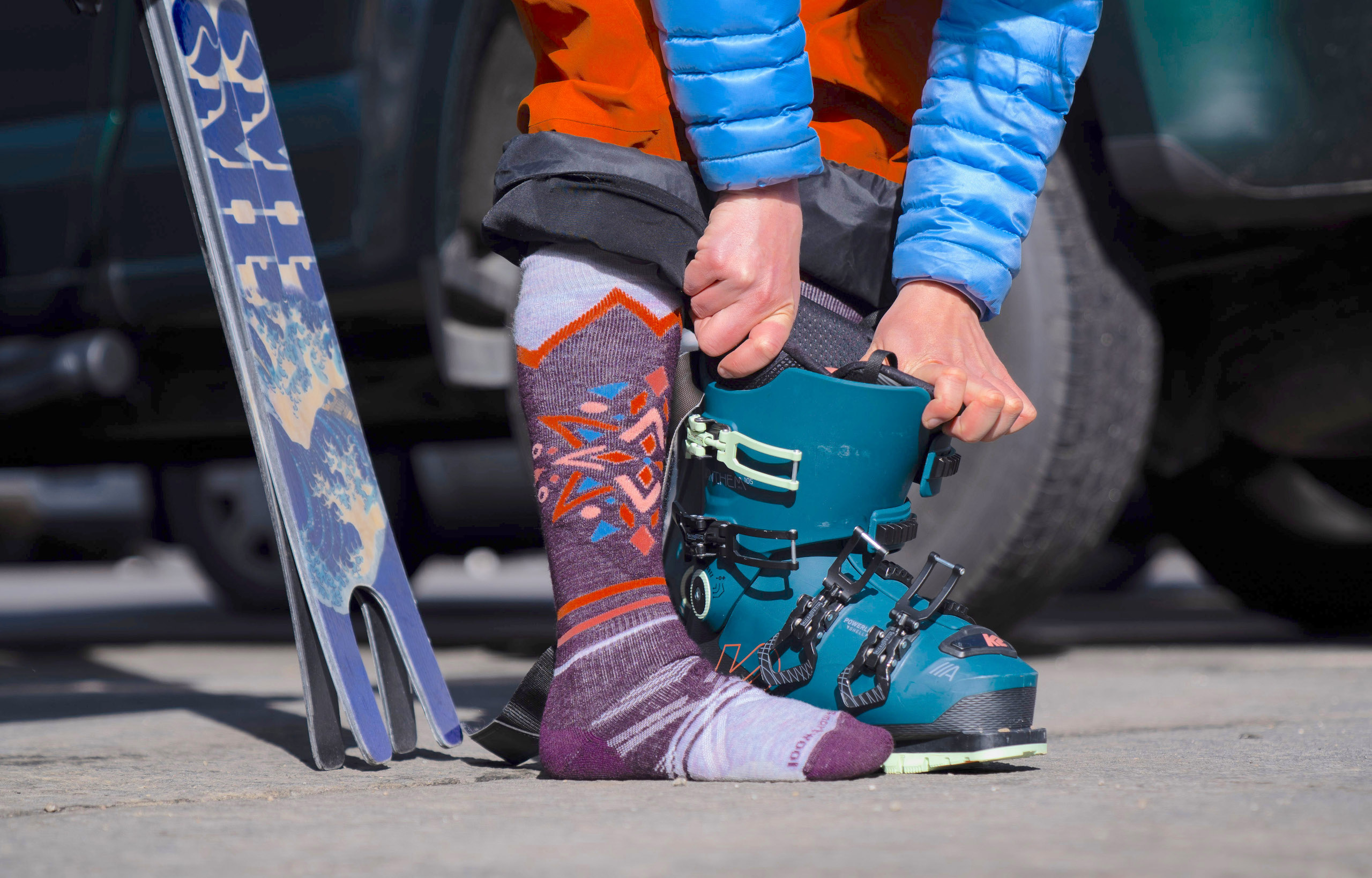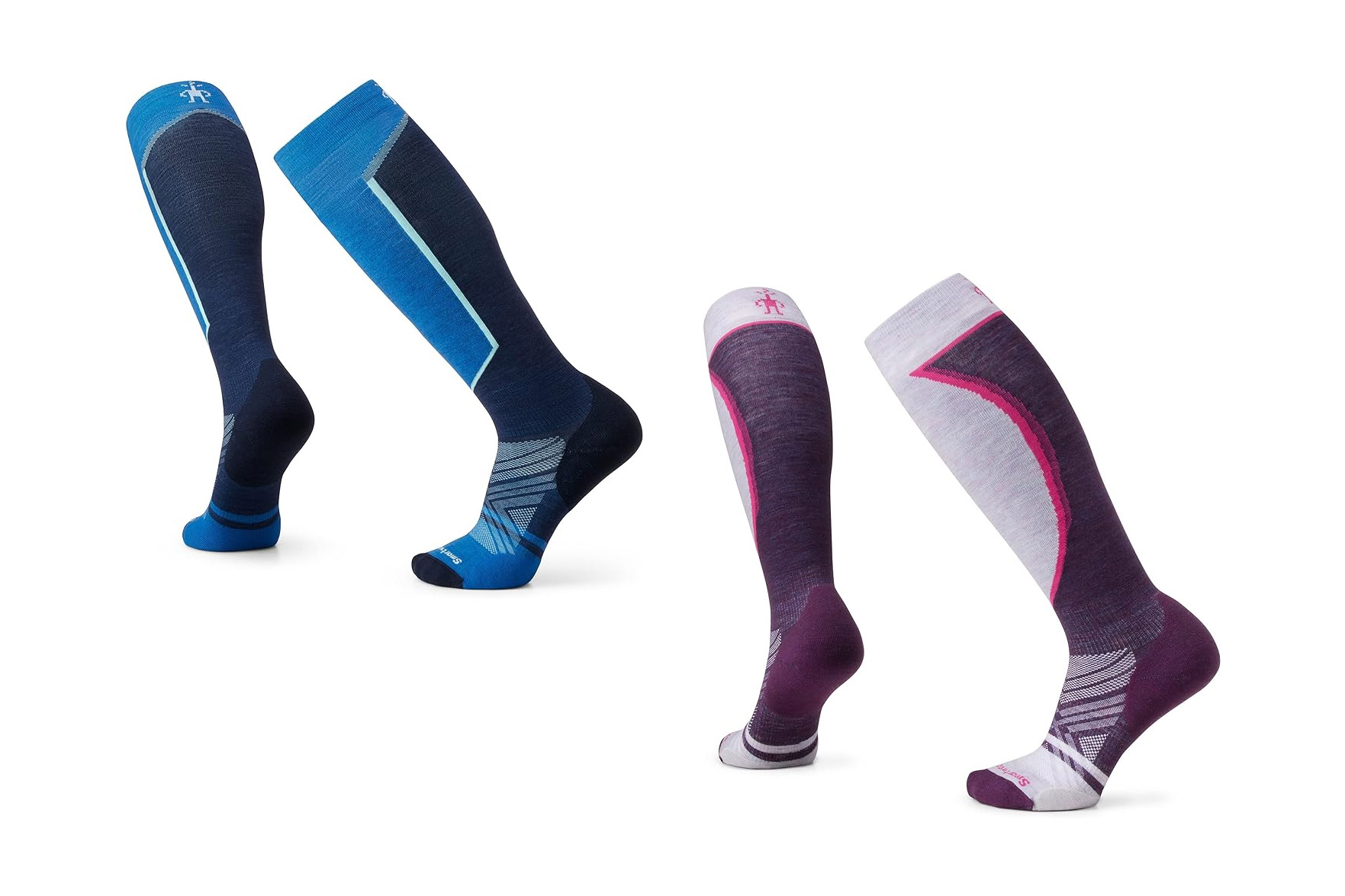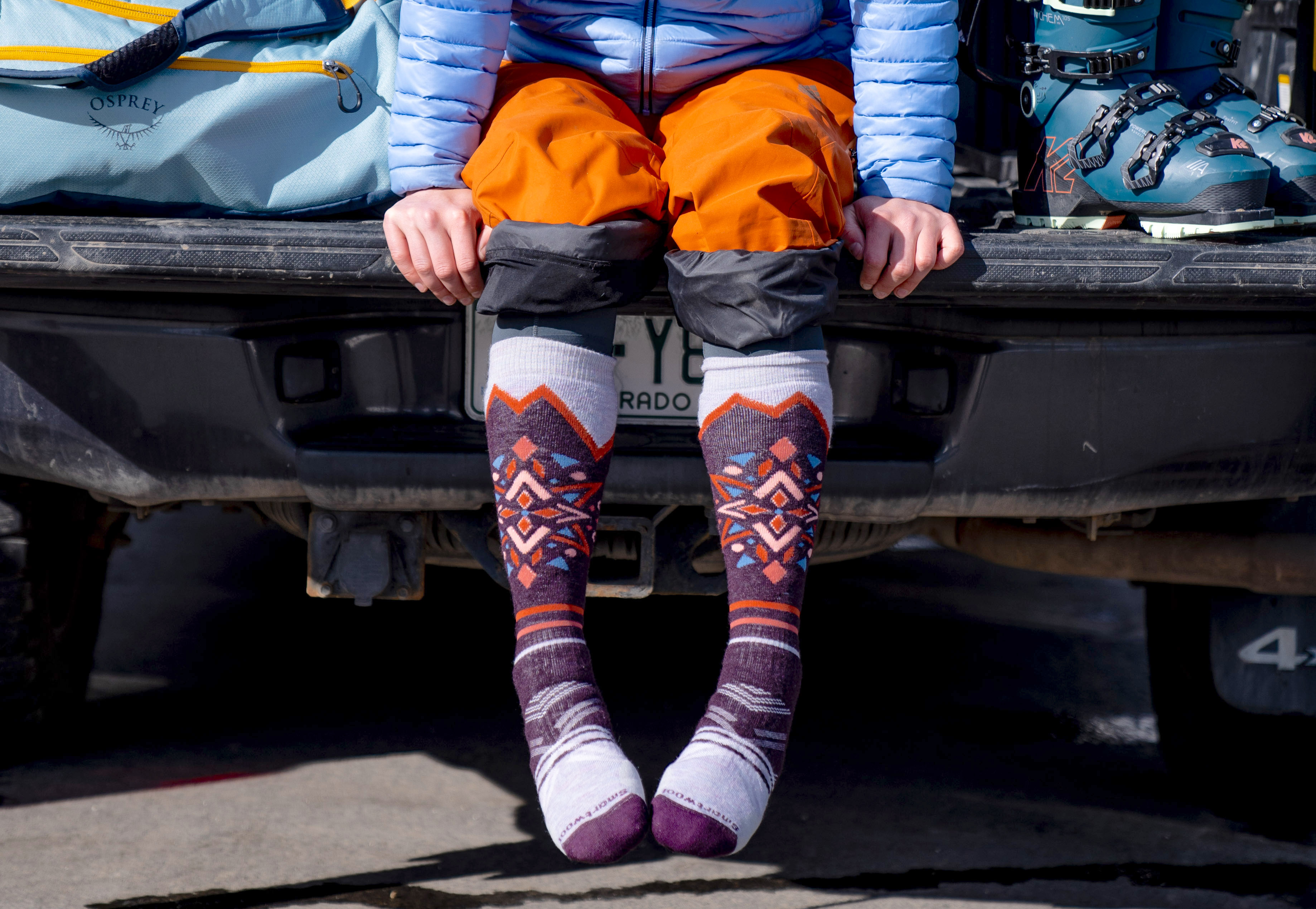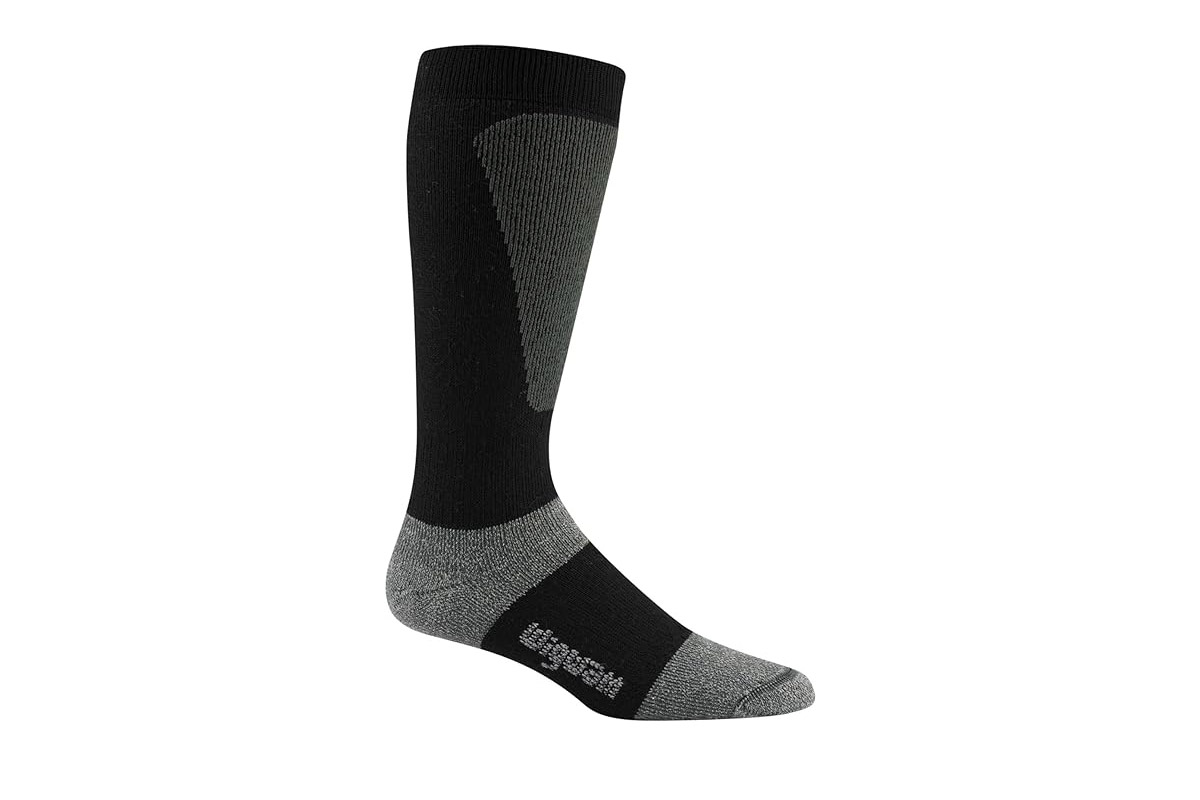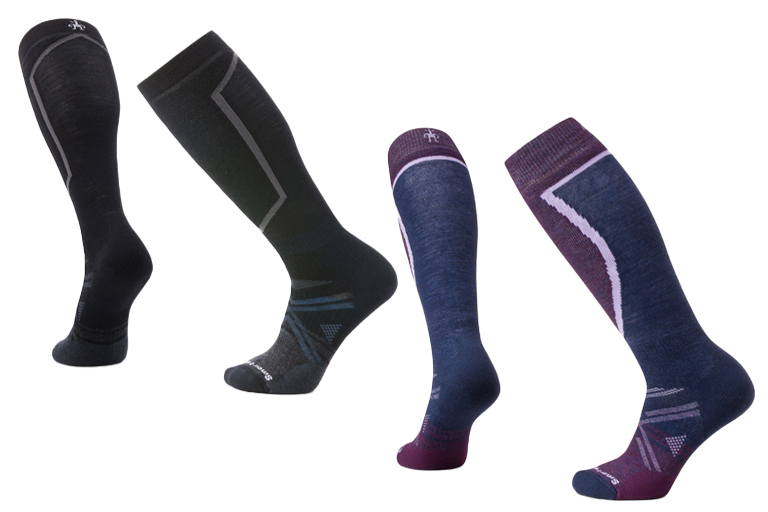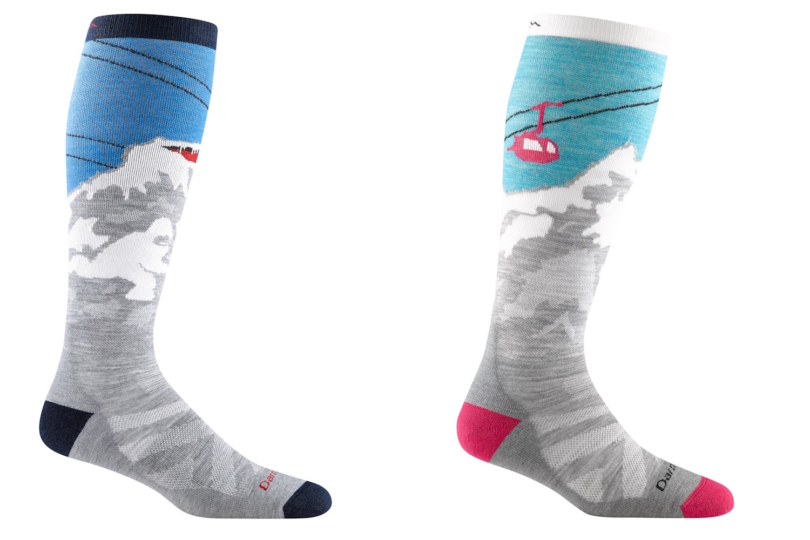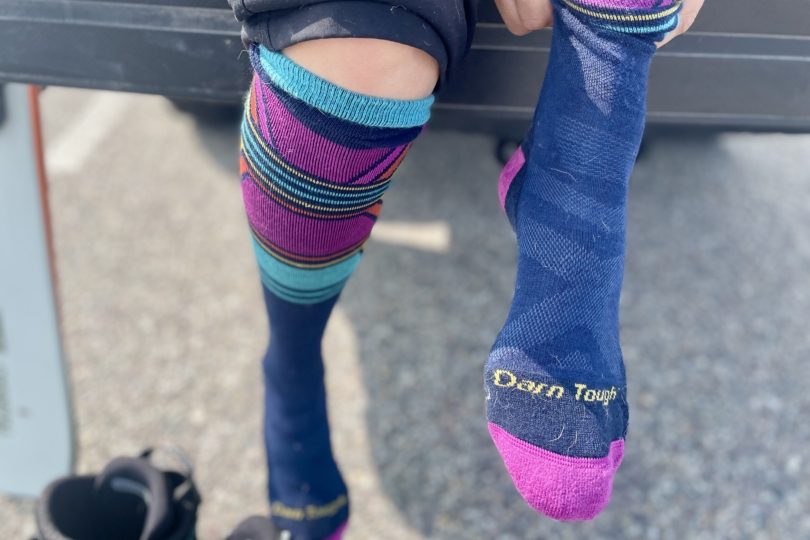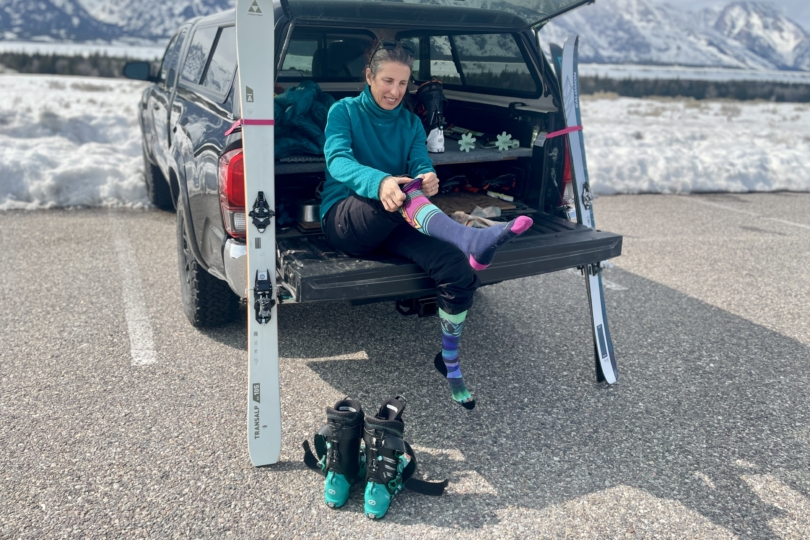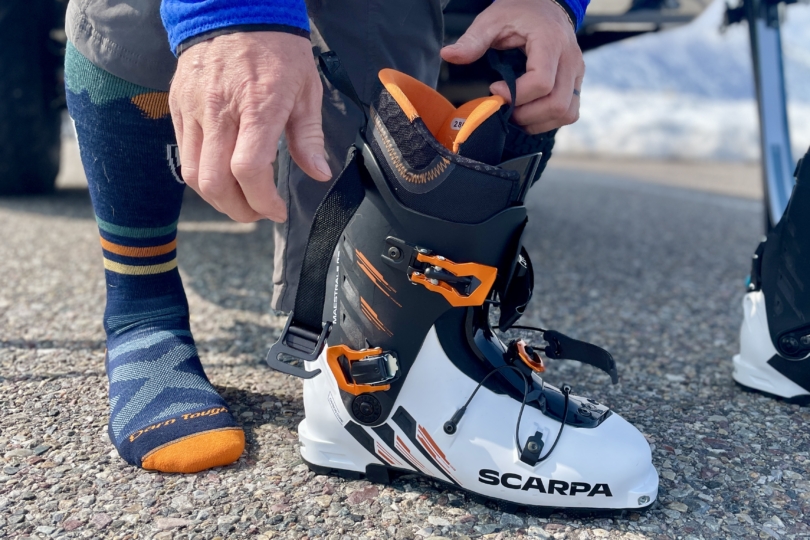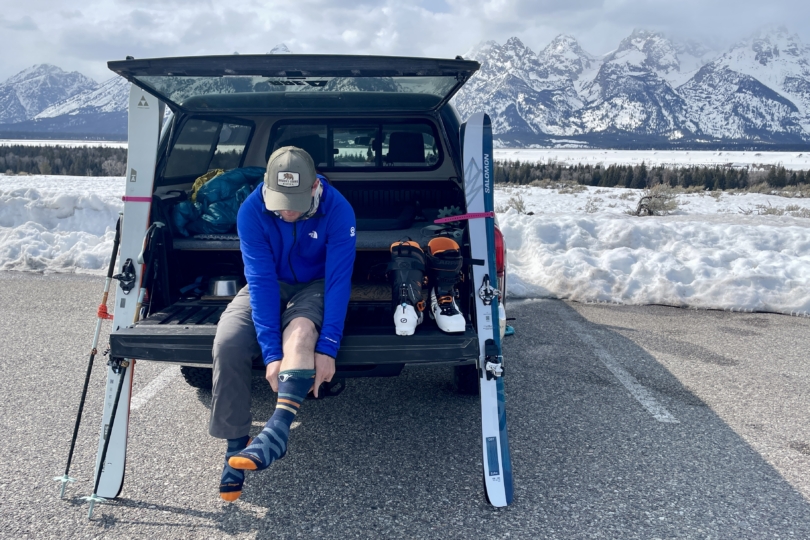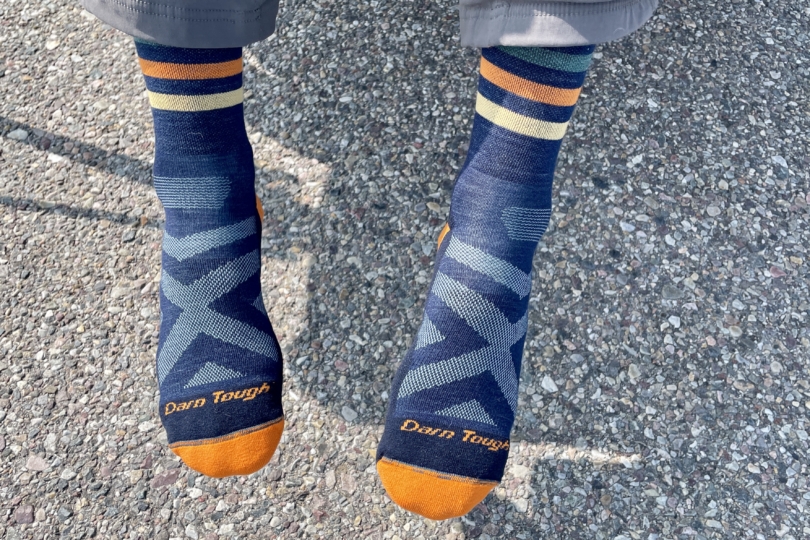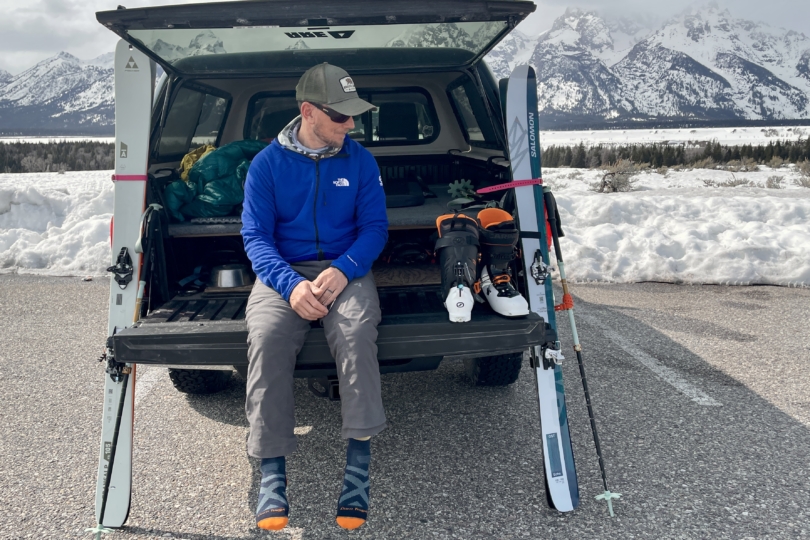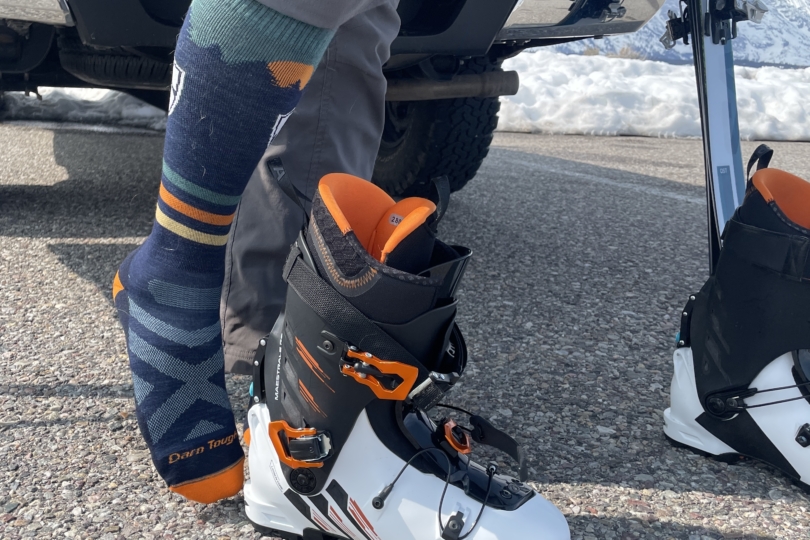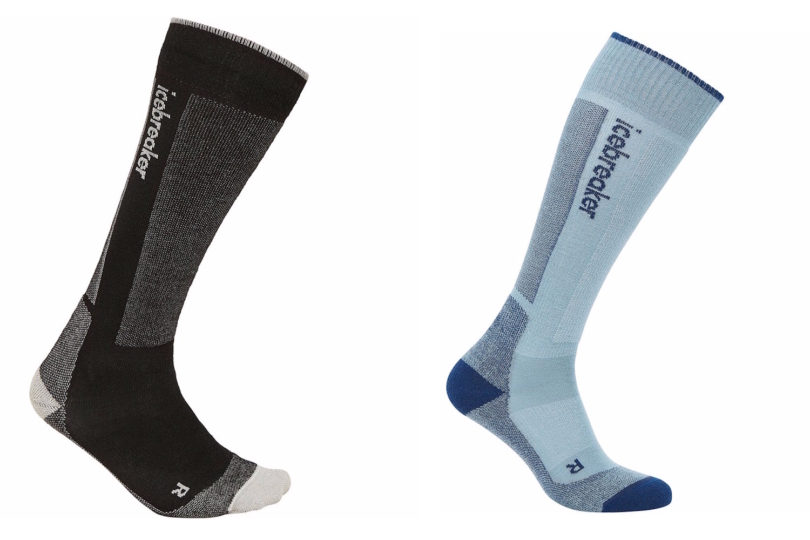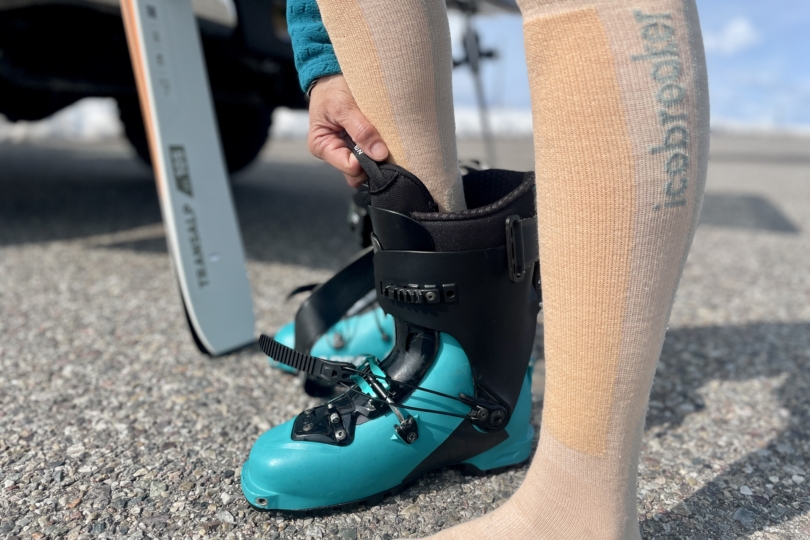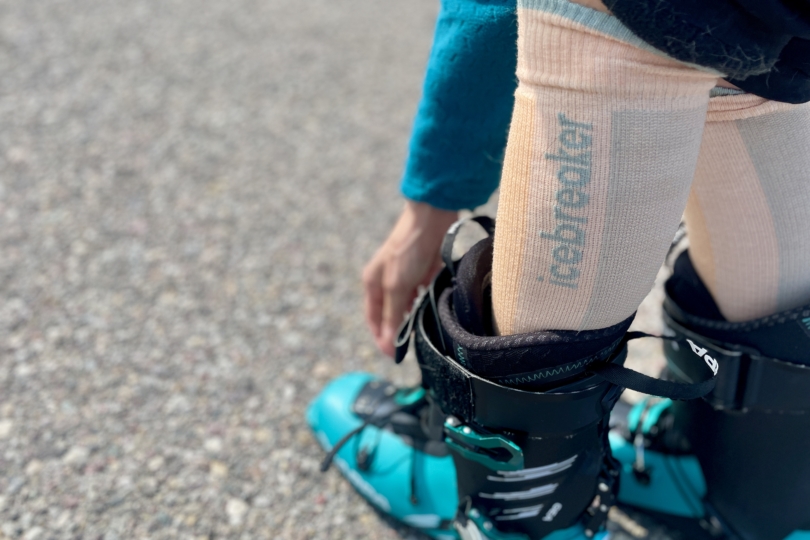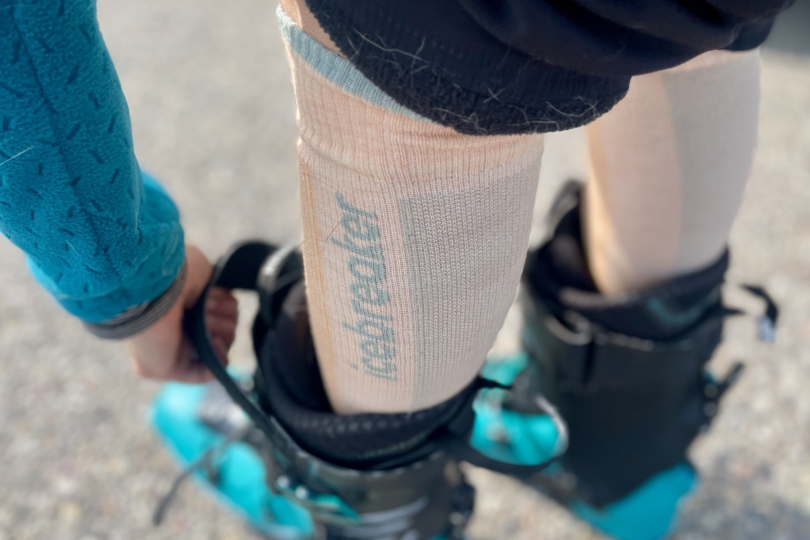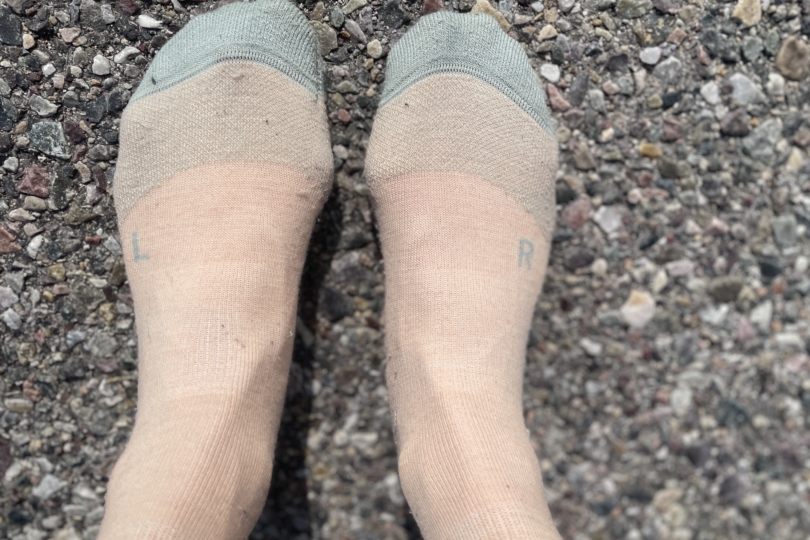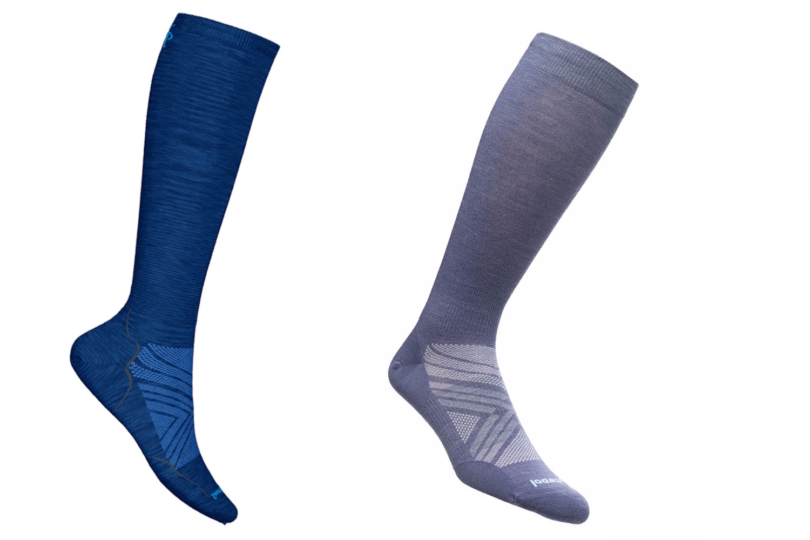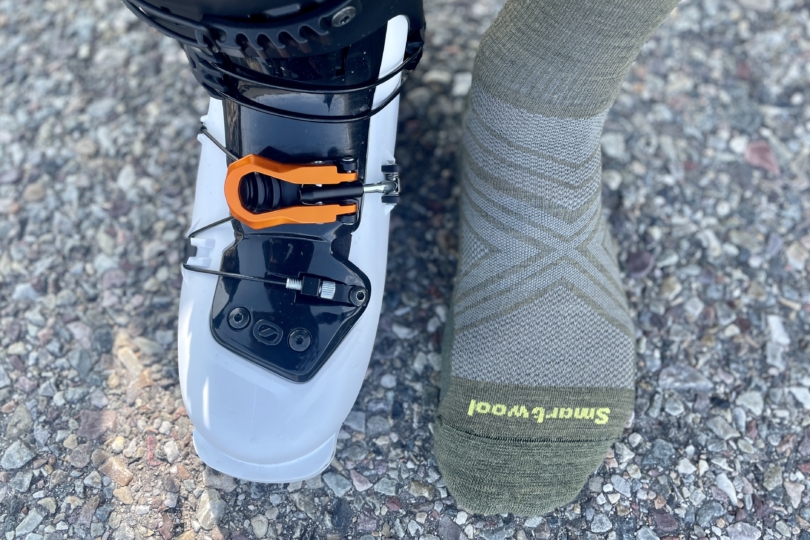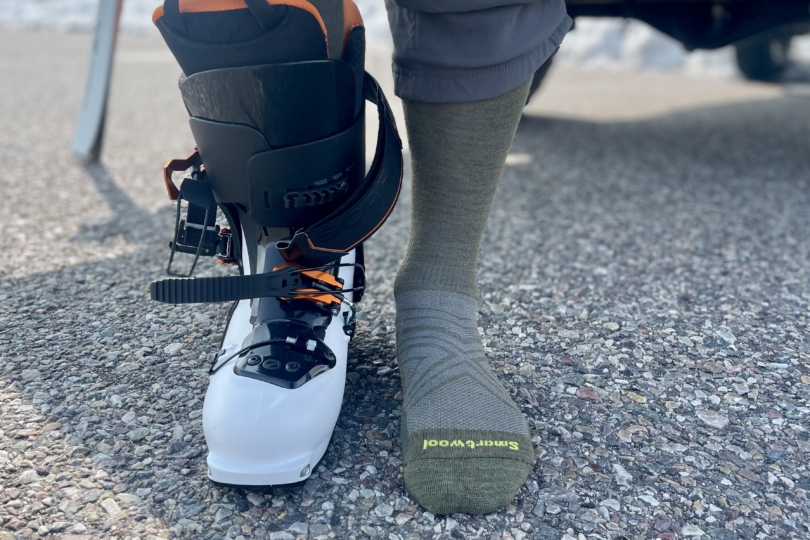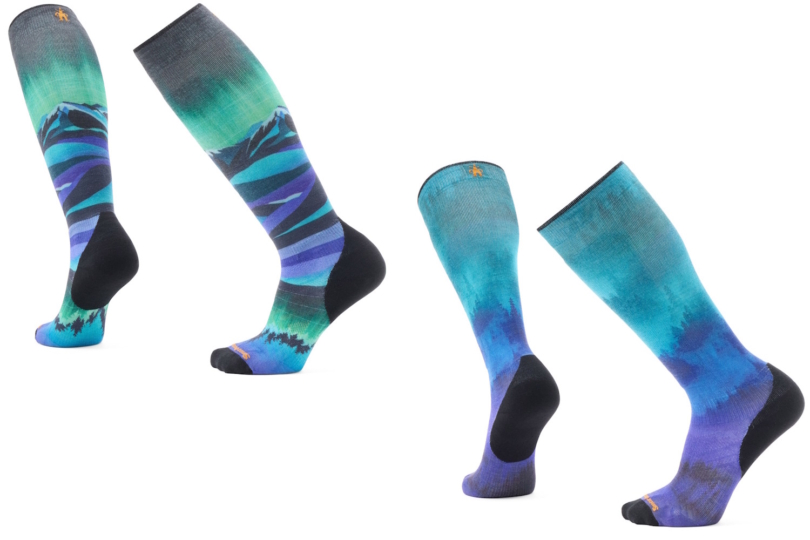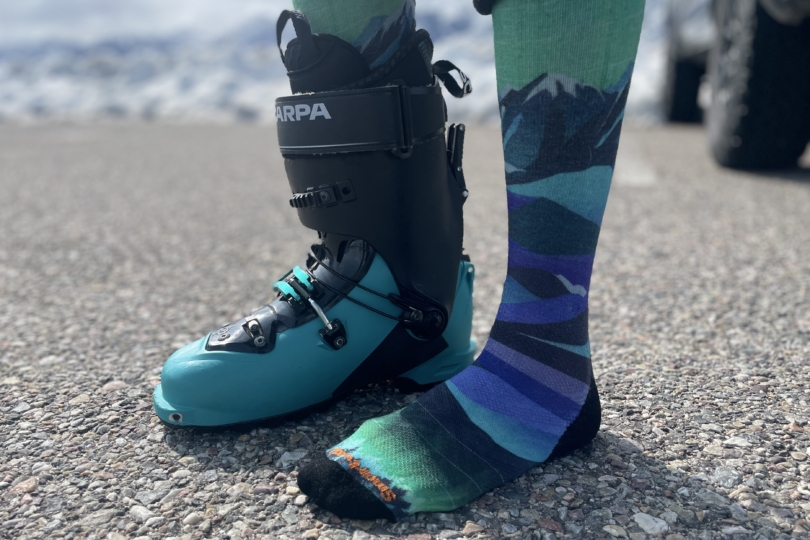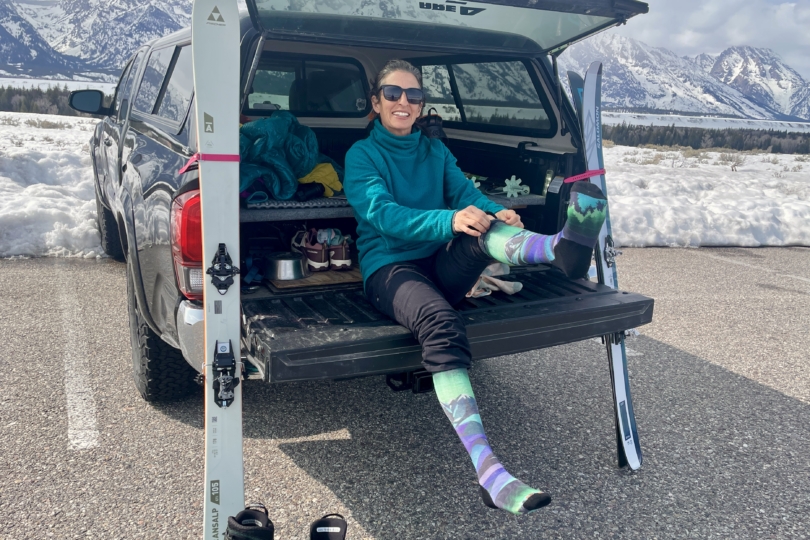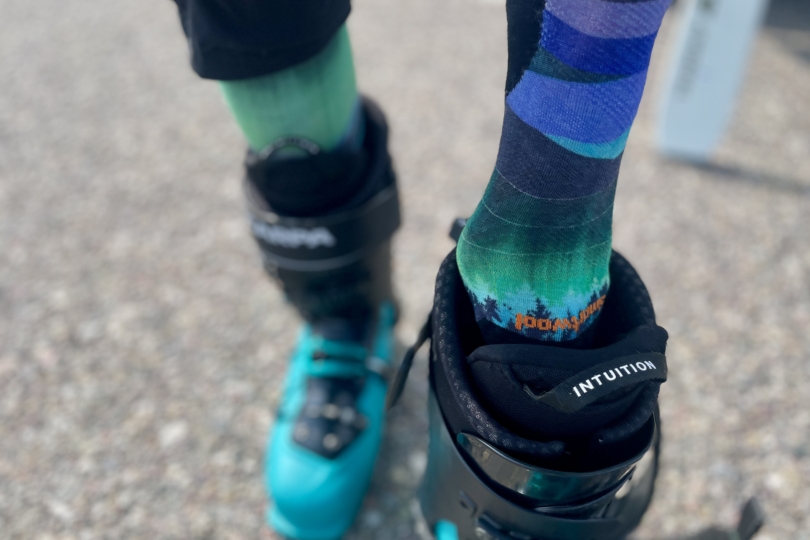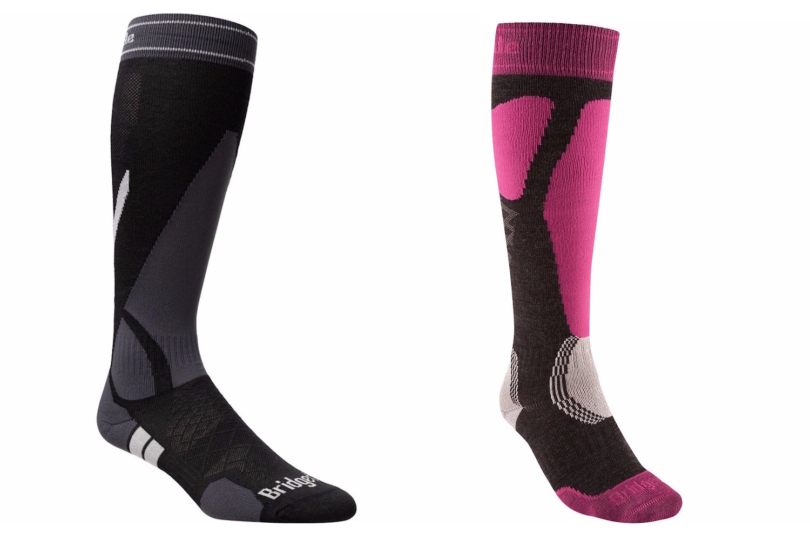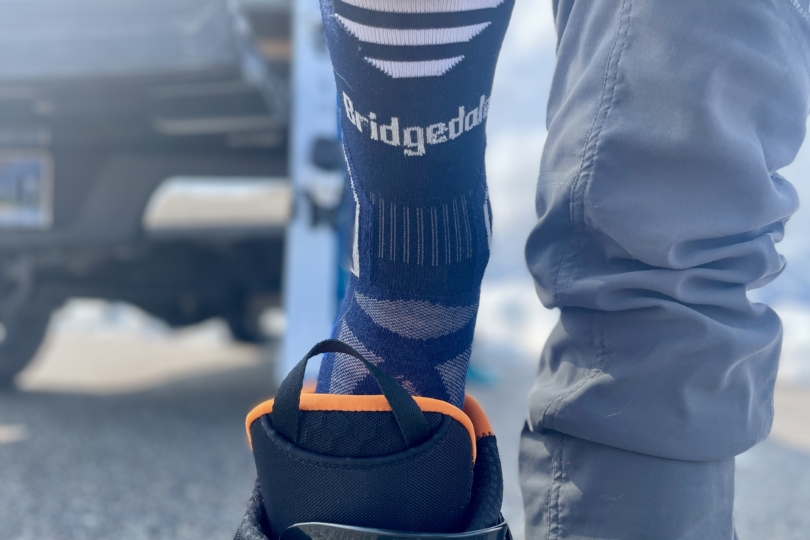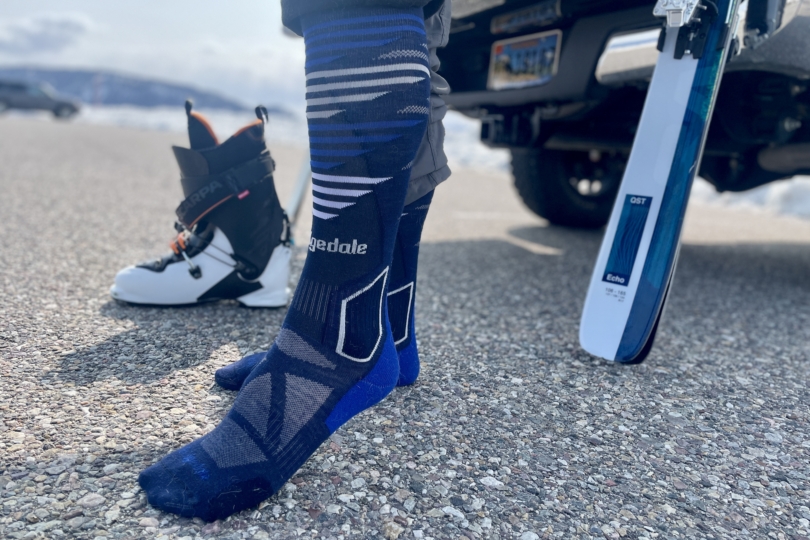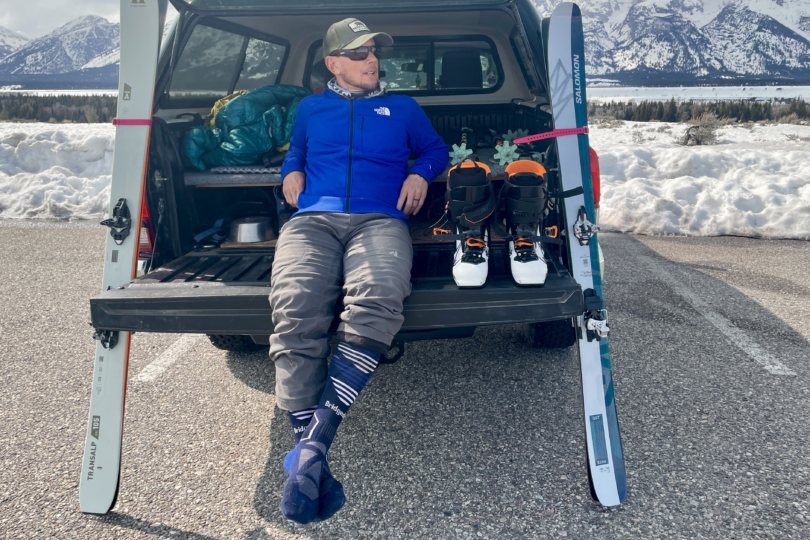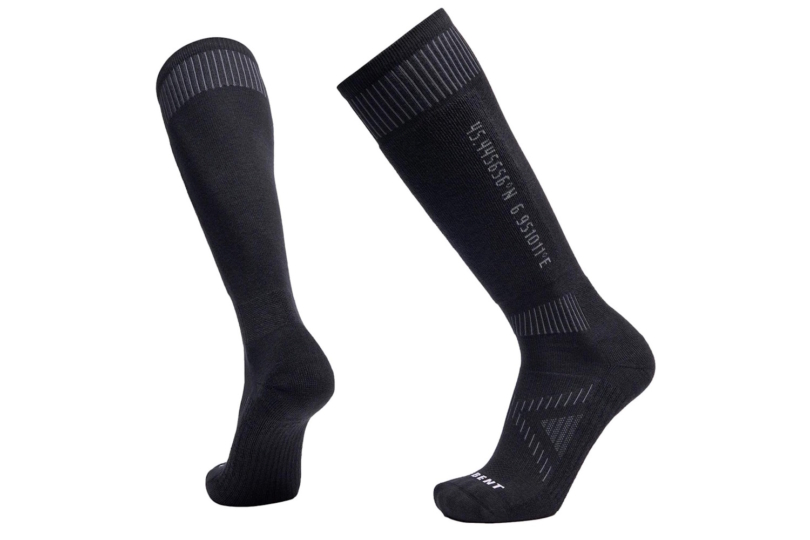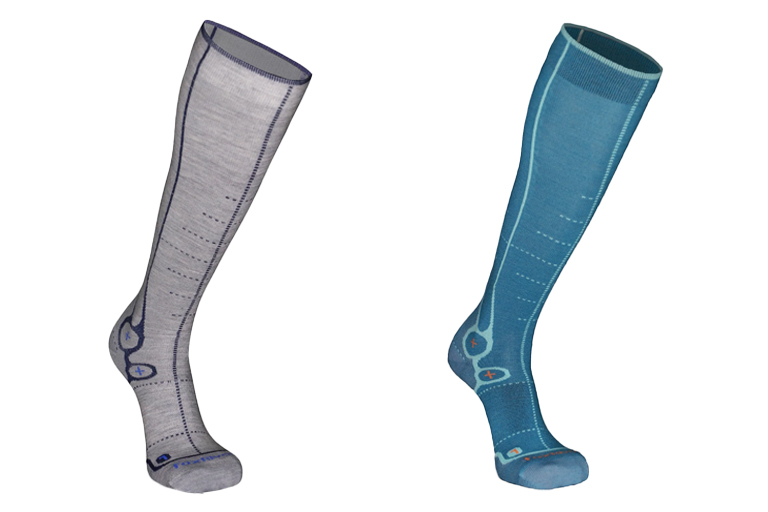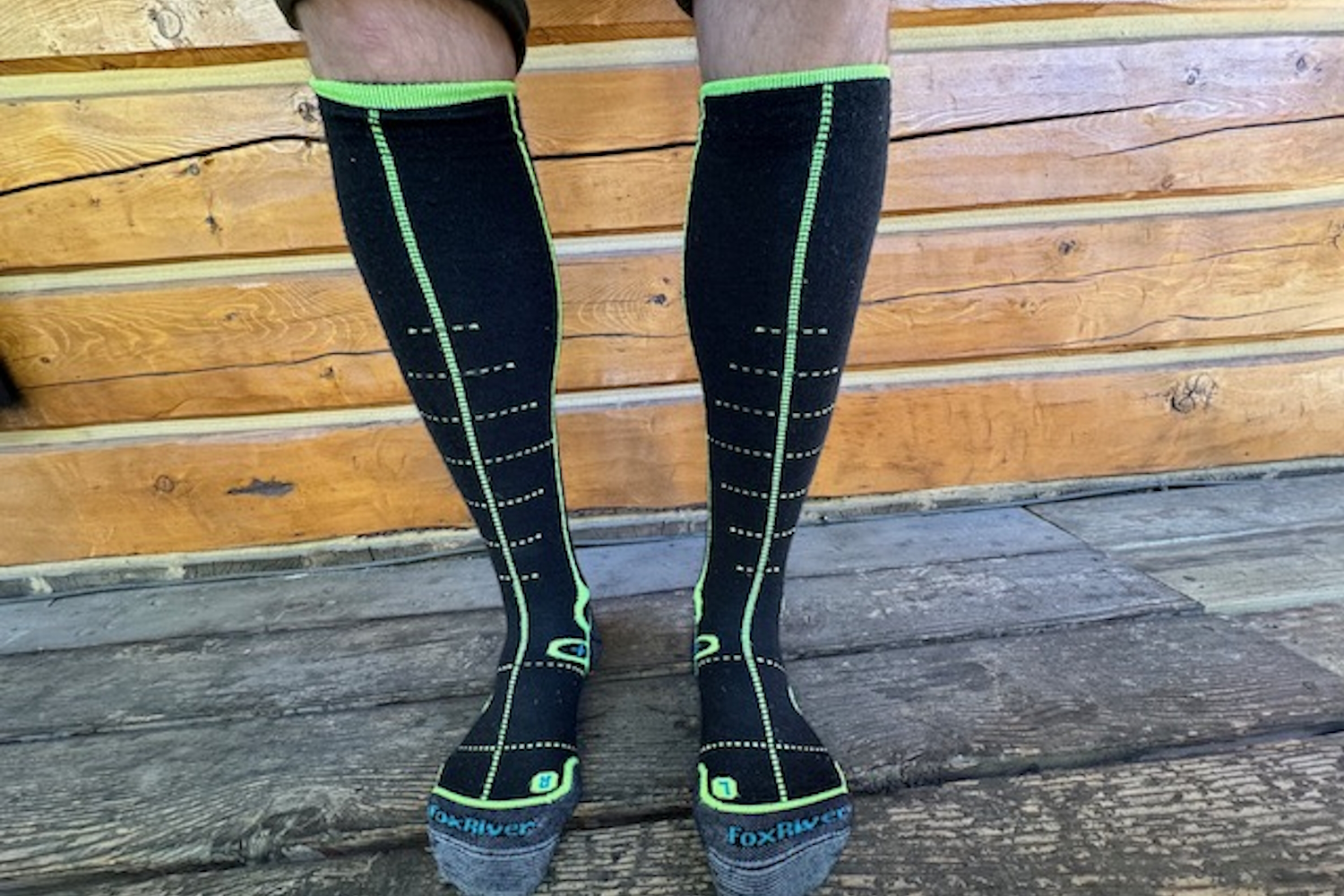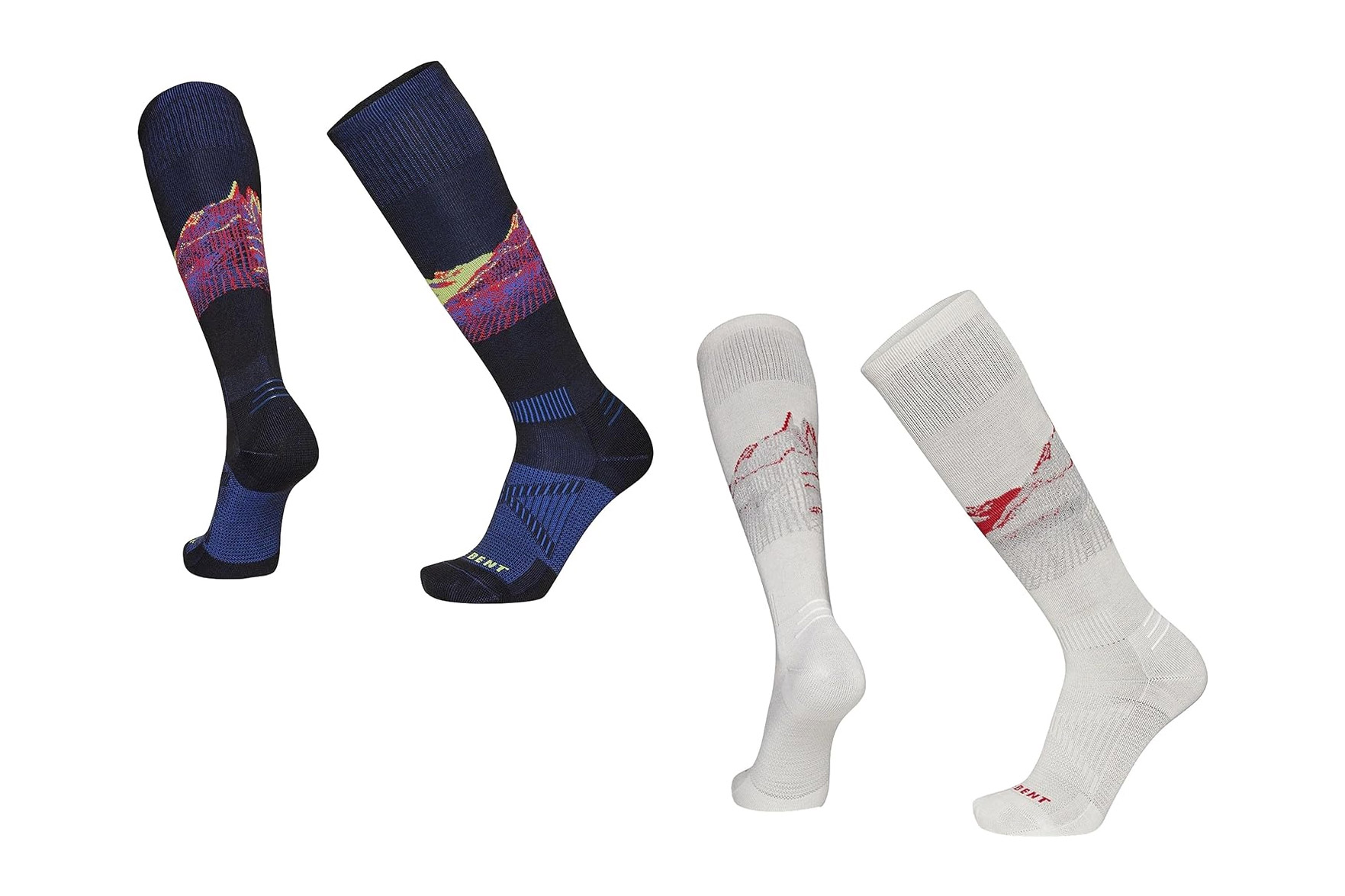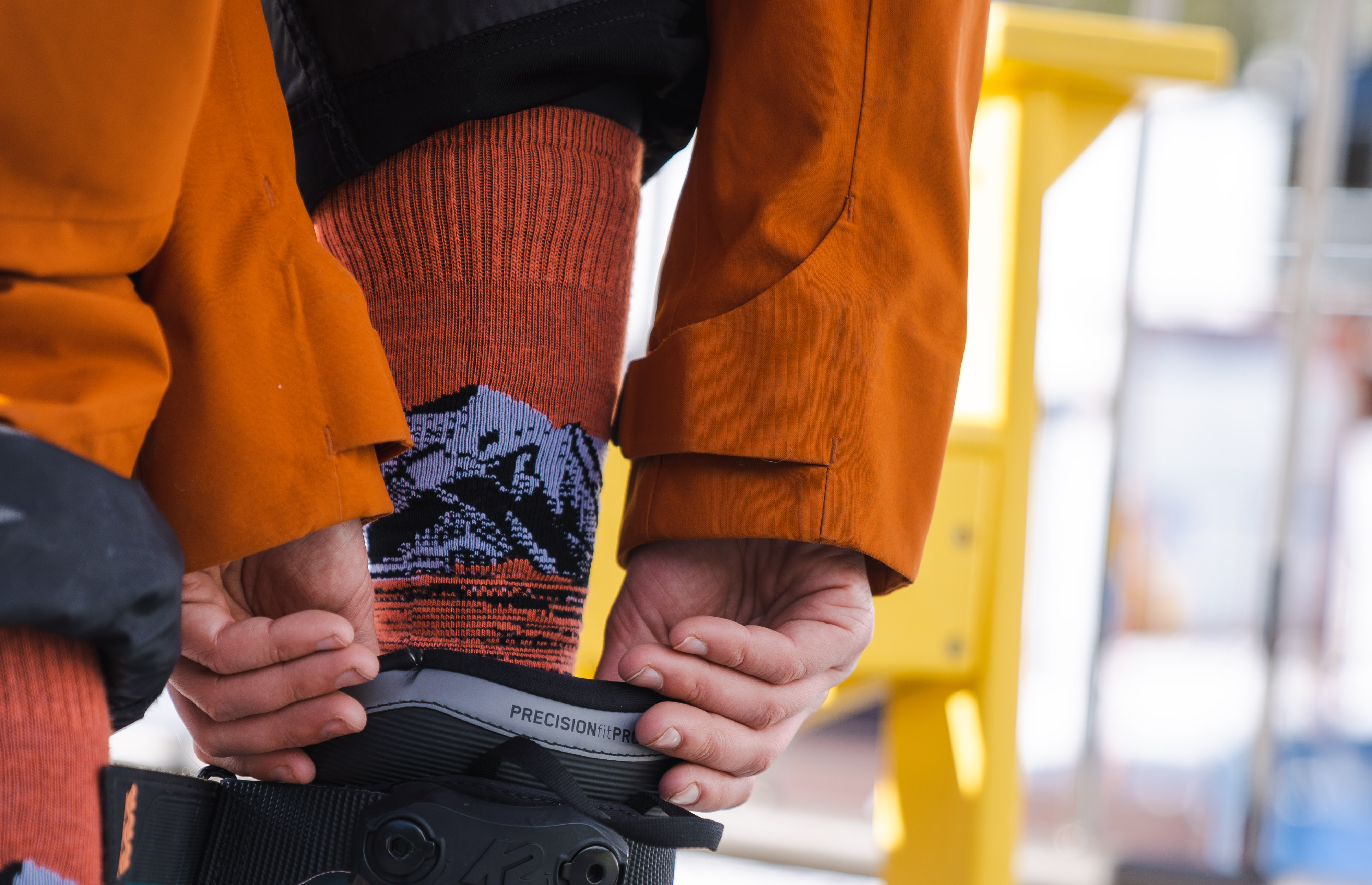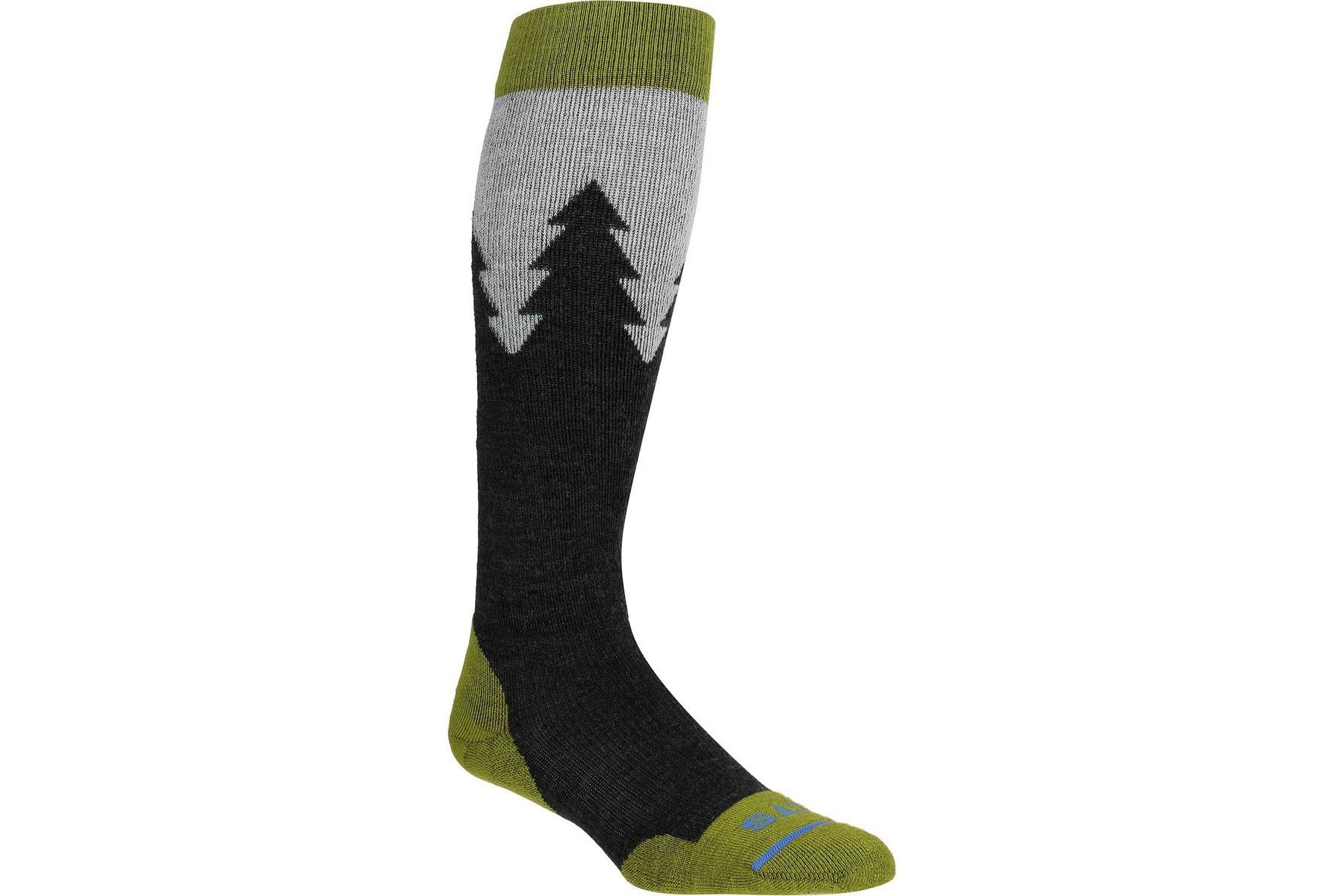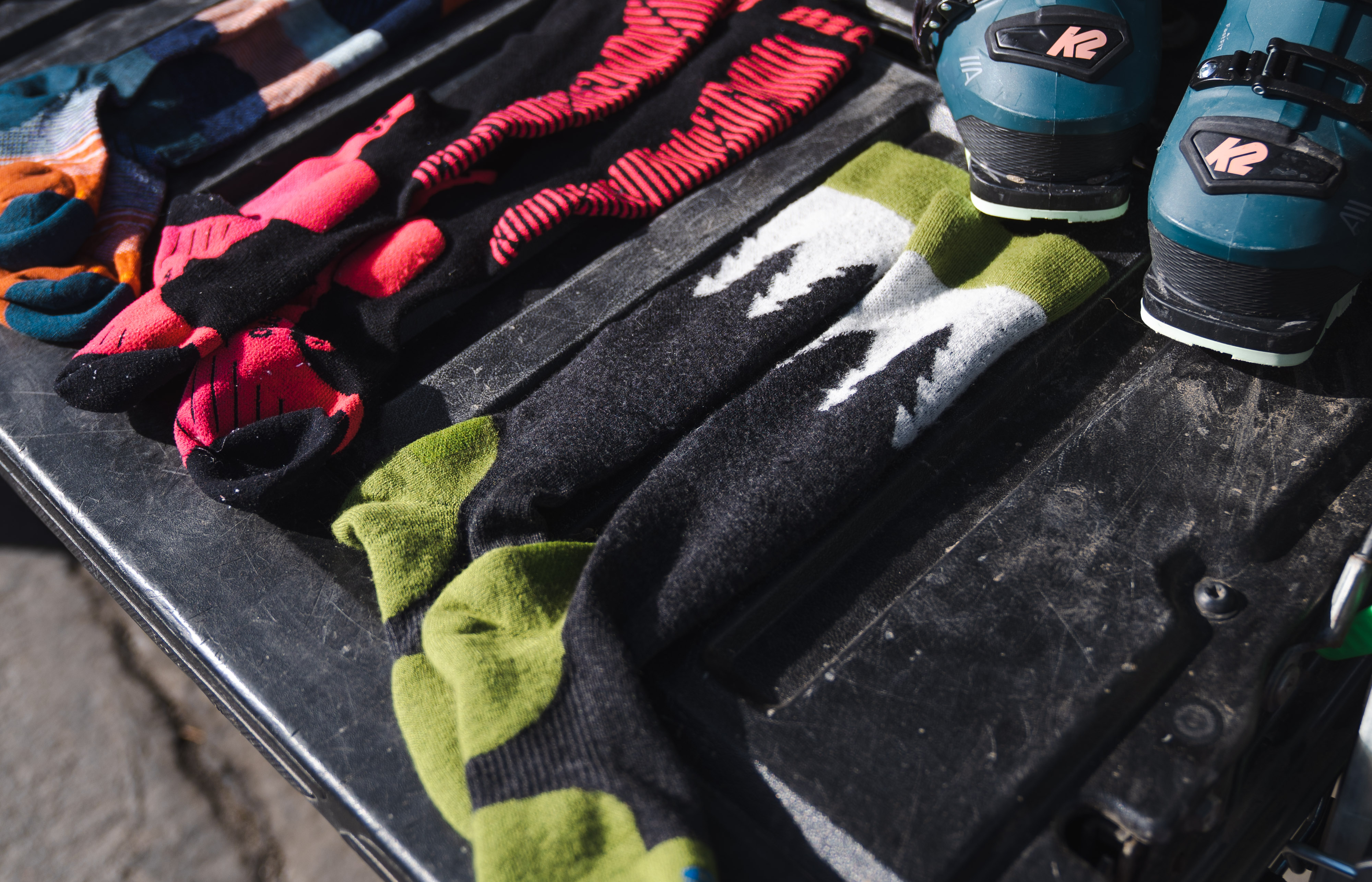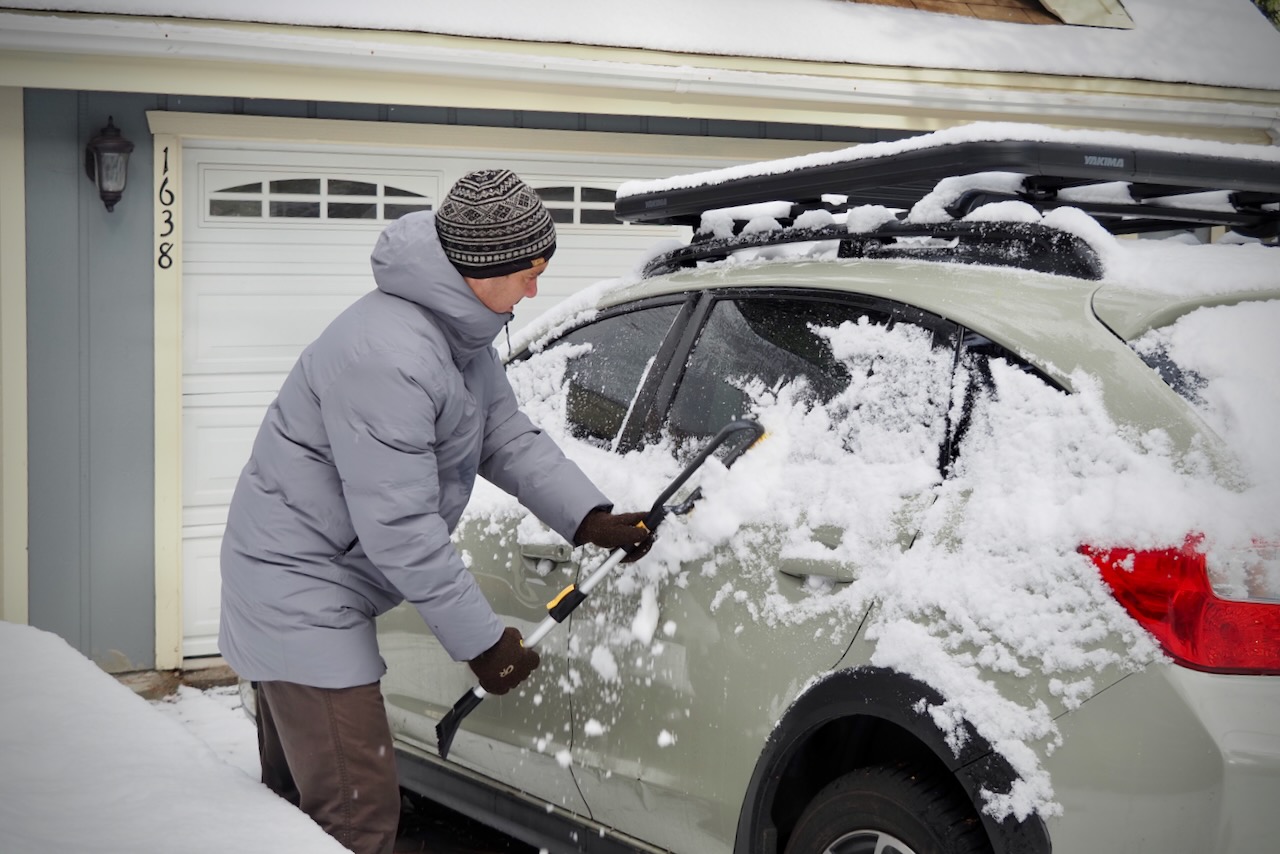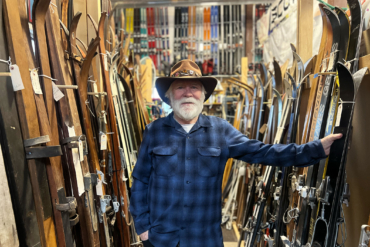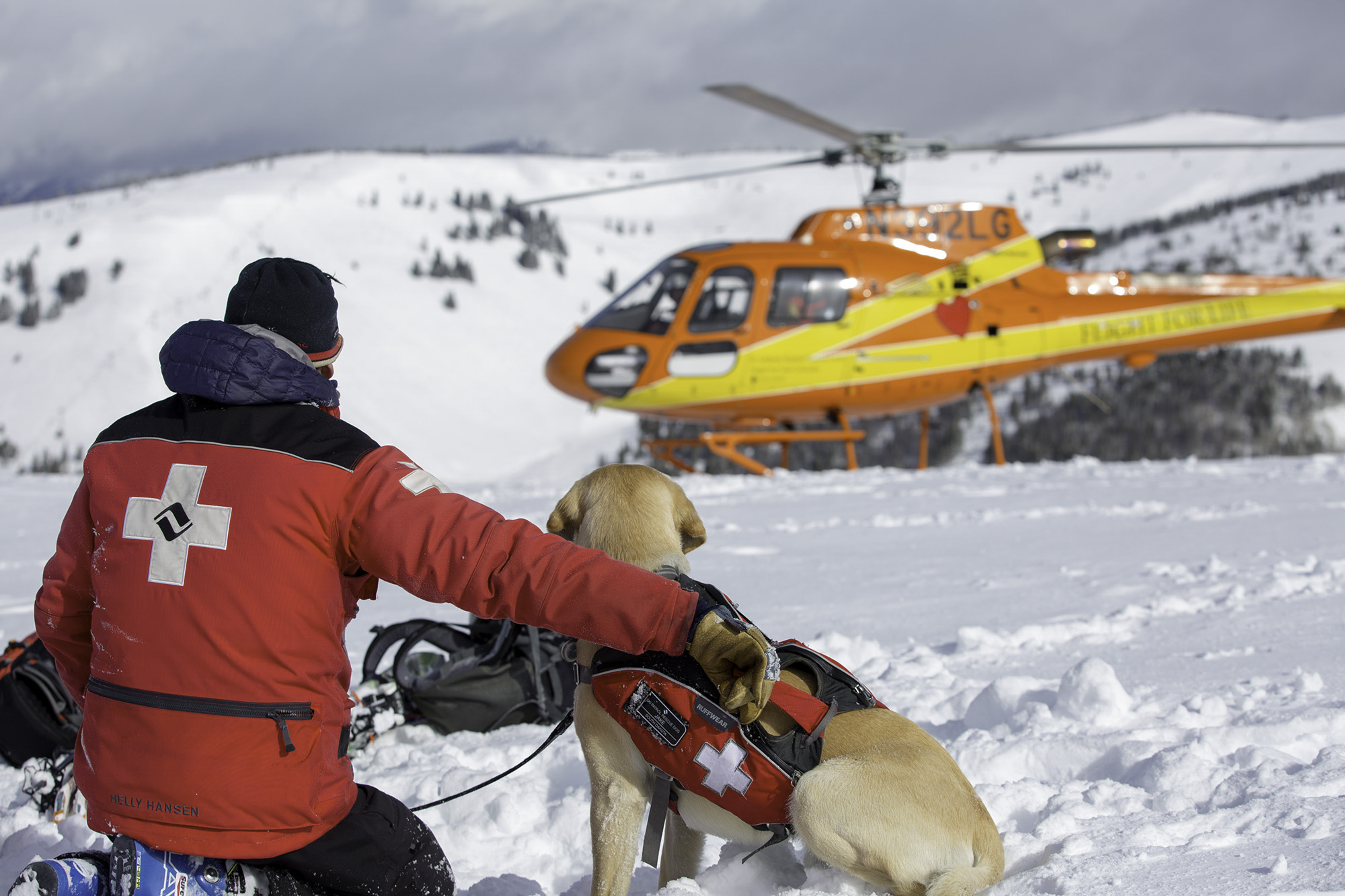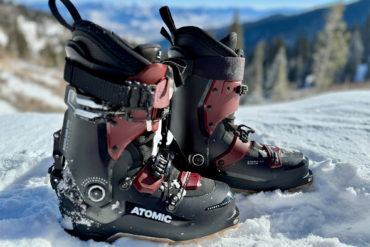Nobody likes cold, clammy, or tingly feet. Seemingly simple, the best ski socks are actually a highly technical layer that plays a crucial role in keeping your feet warm, dry, and comfortable from first chair to last run. Finding the right pair for your foot shape, circulation, and activity level, as well as for the day’s temperature and snow conditions, can make all the difference between cutting the day short and squeezing in those last perfect turns.
Over the past five years, we’ve tested dozens of ski socks to find the best performers for every type of skier and rider. Led by GearJunkie Editors Chris Kassar and Morgan Tilton, our snowsports testers have worn these socks everywhere from icy resort groomers to deep backcountry powder days. We also pulled them on for other winter pursuits including sledding, snowshoeing, snowmobiling, and shoveling to see how they hold up beyond the ski hill.
Our best overall pick, the Smartwool Ski Targeted Cushion OTC Socks, use merino wool for warmth and breathability, and the design has a smooth, secure fit that excels in ski boots. Our budget-friendly option, the Wigwam Sirocco, delivers dependable heat retention and comfort at a price that’s hard to beat. No matter your style, skill level, or budget, these are the best ski socks to keep your feet dry, insulated, and happy all winter long.
Editor’s Note: We updated this guide on October 31, 2025, with detailed ratings and seven new pairs including four award winners: the Darn Tough OTC Midweight, a top mid-cushion pick for warmth and durability; the Smartwool Ski Zero Cushion Over the Calf Socks, the top choice for precision and breathability; the Icebreaker Ski+ Light, recognized for its soft, balanced comfort; and the Smartwool Ski Full Cushion, the warmest and coziest option for cold resort days.
The Best Ski Socks of 2025-2026
Smartwool Targeted Cushion OTC Ski Socks
-
Comfort
9.6
-
Warmth
9.2
-
Fit
9.5
-
Durability
9.1
- Fabric: 57% Merino Wool, 10% Nylon, 30% Recycled Nylon, 3% Elastane
- Thickness: Medium
- Length: Over the calf
Pros
- Excellent warmth-to-breathability balance
- Targeted cushion zones for comfort and support
- Secure, stay-put fit with wide welt
- Seamless toe prevents pressure points
Cons
- Some pilling after use
Wigwam Sirocco
-
Comfort
8.3
-
Warmth
8.5
-
Fit
7.4
-
Durability
7.5
- Fabric: 60% wool, 30% stretch nylon, 9% stretch polyester, 1% spandex
- Thickness: Medium
- Length: Mid-calf
Pros
- Excellent value for the price
- Warm, fully cushioned design
- Secure fit with wide cuff
Cons
- Slightly bulkier feel than premium merino options
Smartwool Full Cushion OTC Ski Socks
-
Comfort
9.2
-
Warmth
9.6
-
Fit
8.7
-
Durability
8.4
- Fabric: 63% merino wool, 10% nylon, 25% recycled nylon, 2% elastane
- Thickness: Light/medium
- Length: Over the calf
Pros
- Seamless fit
- Holds up to many washes
- Cushioning allows for a comfortable fit with reduced movement
Cons
- Recycled material percentages vary depending on pattern choice
- Texture of fabric is a bit rigid
Darn Tough OTC Midweight Ski & Snowboard Socks
-
Comfort
8.7
-
Warmth
9.1
-
Fit
8.3
-
Durability
9.5
- Fabric: 49% merino wool/48% nylon/3% LYCRA spandex
- Thickness: Medium
- Length: Knee-high
Pros
- Extremely durable construction
- Excellent compression and support
- Warm, moisture-wicking merino blend
- Lifetime guarantee
Cons
- Tighter, firmer fit than softer merino blends
Icebreaker Merino Ski+ Light OTC Ski Socks
-
Comfort
9.0
-
Warmth
8.2
-
Fit
9.0
-
Durability
8.5
- 52% Merino Wool, 47% Nylon, 1% Elastane.:
- Thickness: Light
- Length: Over the Calf
Pros
- Warm & Comfortable
- Excellent temperature regulation
- Perfect fit
Cons
- Can pill with repeated washing and drying
Smartwool Zero Cushion OTC Ski Socks
-
Comfort
8.0
-
Warmth
7.0
-
Fit
9.2
-
Durability
7.5
- Fabric: 55% Merino Wool 41% Nylon 4% Elastane
- Thickness: Ultralight
- Length: Over-the-Calf
Pros
- Excellent boot feel and precision
- Superb moisture management
- Secure, stay-put fit
- Durable ultralight construction
Cons
- Limited warmth for very cold conditions
Other Top Ski Socks to Keep Your Dogs Cozy
-
Comfort
8.0
-
Warmth
7.3
-
Fit
8.7
-
Durability
8.0
- Fabric: Yarn: 53% Merino Wool 41% Nylon 5% Elastane 1% Polyester
- Thickness: Light
- Length: Over-the-Calf
Pros
- Improves circulation and reduces fatigue
- Snug, stay-put fit
- Moisture-wicking merino blend
- Durable and supportive construction
Cons
- Less insulation than cushioned models
-
Comfort
8.1
-
Warmth
7.9
-
Fit
7.0
-
Durability
7.1
- Fabric: 60% nylon polyamide/19% merino wool/19% Endurofil polypropylene/2% LYCRA elastane
- Thickness: Medium
- Length: Knee-high
Pros
- Easy to pull on and off
- Soft, warm merino blend
- Excellent durability and fit retention
- Targeted cushioning for comfort
Cons
- Slightly thicker than ideal for performance race boots
-
Comfort
7.5
-
Warmth
6.5
-
Fit
8.9
-
Durability
8.5
- Fabric: 8% Nanoglide, 28% Lycra, 64% Polyamide
- Thickness: Light
- Length: Calf
Pros
- Breathable
- Form-fitting anatomical design
Cons
- Expensive
-
Comfort
7.9
-
Warrmth
8.2
-
Fit
7.2
-
Durability
7.0
- Fabric: 53% Merino Wool, 45% Nylon, 2% LYCRA®
- Thickness: Medium
- Length: Over the Calf
Pros
- Good warmth to thickness ratio
- Stretchy and comfortable
- Moderate padding in key areas
Cons
- Too stretchy for ski touring
-
Comfort
7.5
-
Warmth
7.0
-
Fit
8.0
-
Durability
5.5
- Fabric: 46% rayon from bamboo, 32% nylon, 20% Merino wool, 2% elastane
- Thickness: Light
- Length: Over the calf
Pros
- Smooth seamless texture
- Odor-resistant
- Rubber heel and calf lock
Cons
- Expensive
- Fabric wears down faster
-
Comfort
7.2
-
Warmth
7.8
-
Fit
8.0
-
Durability
7.0
- Materials: 57% Merino Wool, 10% Nylon, 30% Recycled Nylon, 3% Elastane
- Thickness: Medium
- Length: Over the calf
Pros
- Dialed in fit
- Warm
- Moisture wicking
- Easy boot entry with nano-glide
Cons
- Bulky for ski touring or aerobic activities
-
Comfort
6.9
-
Warmth
6.7
-
Fit
8.8
-
Durability
8.3
- Fabric: 70% polyamide, 18% merino wool, 12% spandex
- Thickness: Light
- Length: Calf
Pros
- Just-right compression
- Quick to dry
Cons
- Not the best choice for the coldest days
- Expensive
-
Comfort
8.6
-
Warmth
7.3
-
Fit
8.4
-
Durability
7.0
- Fabric: 49% Nylon, 28% Bamboo Rayon, 20% Merino Wool, 3% Elastane
- Thickness: Light-medium
- Length: Knee-height
Pros
- Silicone strips help sock stay up and prevent heel movement
- Extremely soft
- Articulated, athletic fit
Cons
- Upper price tier
- Longer length might not be everyone’s top choice
- No cushion might be a no-go for some
-
Comfort
8.4
-
Warmth
7.5
-
Fit
7.7
-
Durability
7.0
- Fabric: 66% Merino Wool, 26% Nylon, 6% Polyester, Lycra-Spandex 2%
- Thickness: Light-to-Medium
- Length: Over the Calf
Pros
- Full contact fit
- Heel lock feature prevents blisters
- Lightweight and breathable
Cons
- Unisex design may not work for everyone
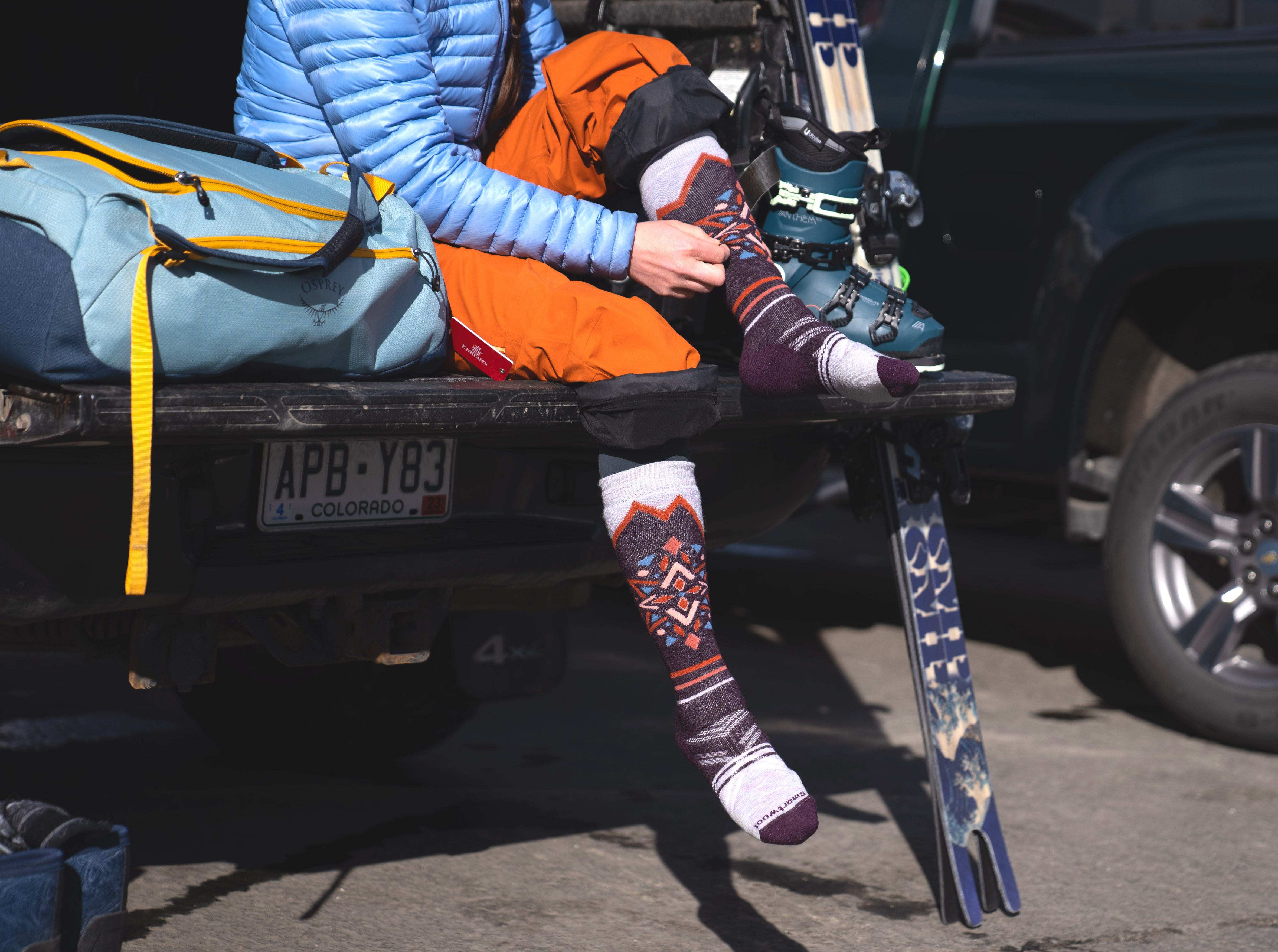
Ski Socks Comparison Chart
Scroll right to view all of the columns: Price, Fabric, Thickness, Length.
| Ski Sock | Price | Fabric | Thickness | Length |
|---|---|---|---|---|
| Smartwool Targeted Cushion OTC Ski Sock | $30 | 57% Merino Wool, 10% Nylon, 30% Recycled Nylon, 3% Elastane | Medium | Over the calf |
| Wigwam Sirocco | $17 | 60% wool, 30% stretch nylon, 9% stretch polyester, 1% spandex | Medium | Mid-calf |
| Smartwool Full Cushion OTC Ski Socks | $31 | 63% merino wool, 10% nylon, 25% recycled nylon, 2% elastane | Light/medium | Over the calf |
| Darn Tough OTC Midweight Ski & Snowboard Socks | $32 | 49% merino wool/48% nylon/3% LYCRA spandex | Knee-high | Over the calf |
| Icebreaker Merino Ski+ Light OTC Ski Socks | $31 | 52% Merino Wool, 47% Nylon, 1% Elastane | Over the Calf | Over the calf |
| Smartwool Zero Cushion OTC Ski Socks | $28 | 55% Merino Wool 41% Nylon 4% Elastane | Ultralight | Over the calf |
| Smartwool Compression OTC Ski Socks | $45 | Yarn: 53% Merino Wool 41% Nylon 5% Elastane 1% Polyester | Light | Over the calf |
| Bridgedale Easy On Merino Endurance Ski Socks | $32 | 60% nylon polyamide/19% merino wool/19% Endurofil polypropylene/2% LYCRA elastane | Medium | Knee-high |
| Dissent GFX Compressio Hybrid | $58 | 8% Nanoglide, 28% Lycra, 64% Polyamide | Light | Calf |
| Icebreaker Medium Over the Calf Socks | $33 | 53% Merino Wool, 45% Nylon, 2% LYCRA® | Medium | Over the calf |
| Le Bent Core Light Snow Sock | $36 | 46% rayon from bamboo, 32% nylon, 20% Merino wool, 2% elastane | Light | Over the calf |
| Fox River Bootfitter Elite Ultra-Lightweight Over-The-Calf Ski Sock | $28 | 57% Merino Wool, 10% Nylon, 30% Recycled Nylon, 3% Elastane | Medium | Over the calf |
| CEP Ski Touring Compression Socks | $60 | 70% polyamide, 18% merino wool, 12% spandex | Light | Calf |
| Le Bent Cody Townsend & Elyse Saugstad Pro Series Zero Cushion | $44 | 49% Nylon, 28% Bamboo Rayon, 20% Merino Wool, 3% Elastane | Light-medium | Knee-height |
| FITS Light Ski Sierra | $28 | 66% Merino Wool, 26% Nylon, 6% Polyester, Lycra-Spandex 2% | Light-to-Medium | Over the Calf |
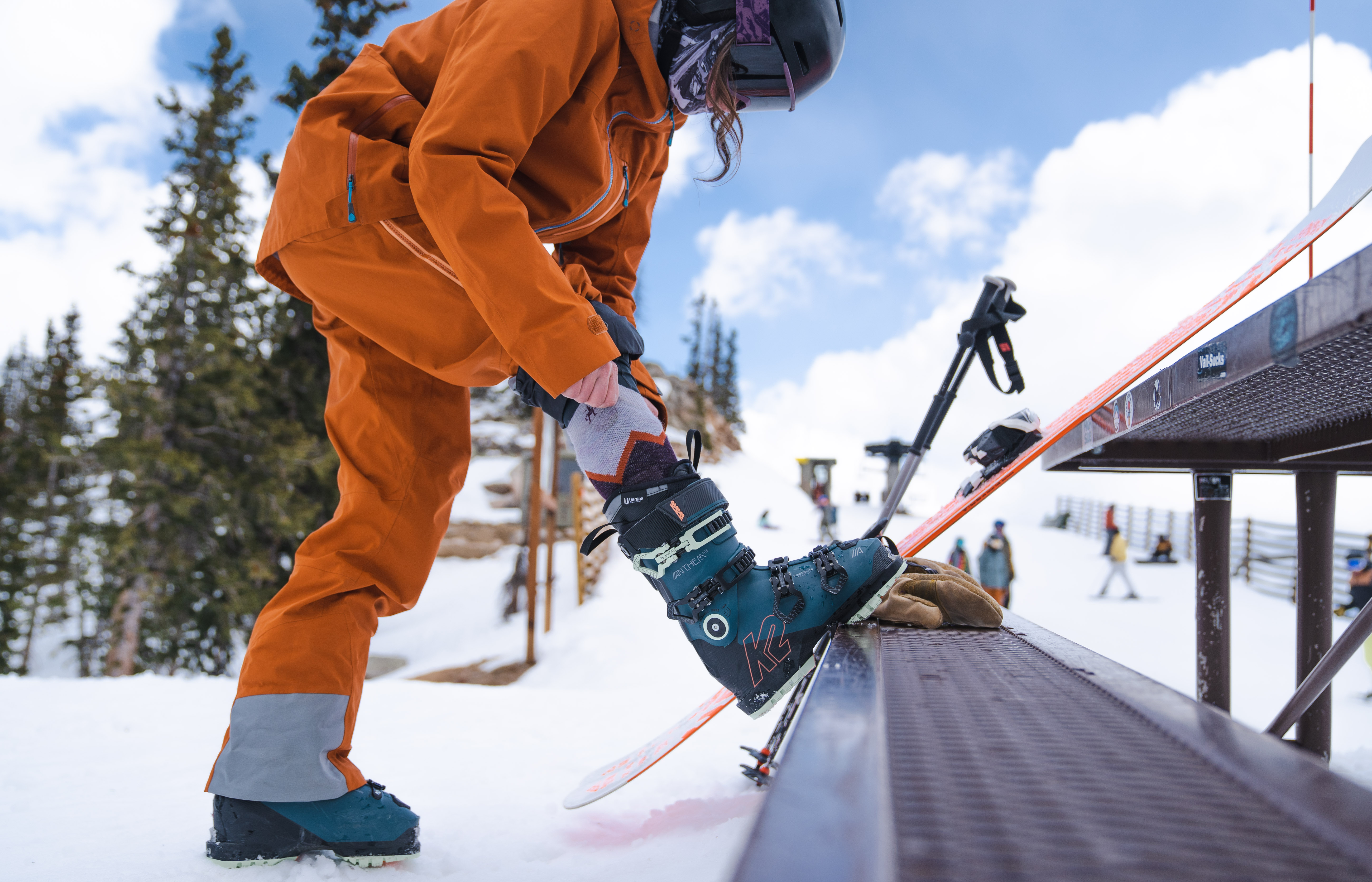
How We Tested the Best Ski Socks
It’s safe to say that our team of GearJunkie testers always puts on ski socks before each ski and ride outing, so we’ve tested a huge variety of technical snow hosiery over the decades.
Our Expert Testers
With more than five years of ski sock testing behind us, the GearJunkie team brings deep experience, cold-weather grit, and on-snow expertise to every recommendation we make. Leading the charge this season are GearJunkie Editor Chris Kassar, as well as bootfitter and ski expert Ryan Kempfer, who have spent the past two years testing ski socks side by side in the Tetons, Colorado, and beyond. They’ve evaluated dozens of models for warmth, comfort, fit, and durability in both resort and backcountry conditions.
This guide was previously led by Senior Editor Morgan Tilton, a lifelong skier and snowboarder with more than 30 years of experience across every facet of snowsports, from backcountry touring and Nordic skiing to off-trail snowmobiling and skimo racing. Tilton’s sock reporting for the Outdoor Retailer Daily and Snow Show Daily trade show publications, as well as deep knowledge and history of snow socks, helped shape the foundation of this comprehensive review.
Additional insights came from Meghan LaHatte and Bergen Tjossem, who contributed their own ski days, field experience, and feedback to round out this year’s testing process.
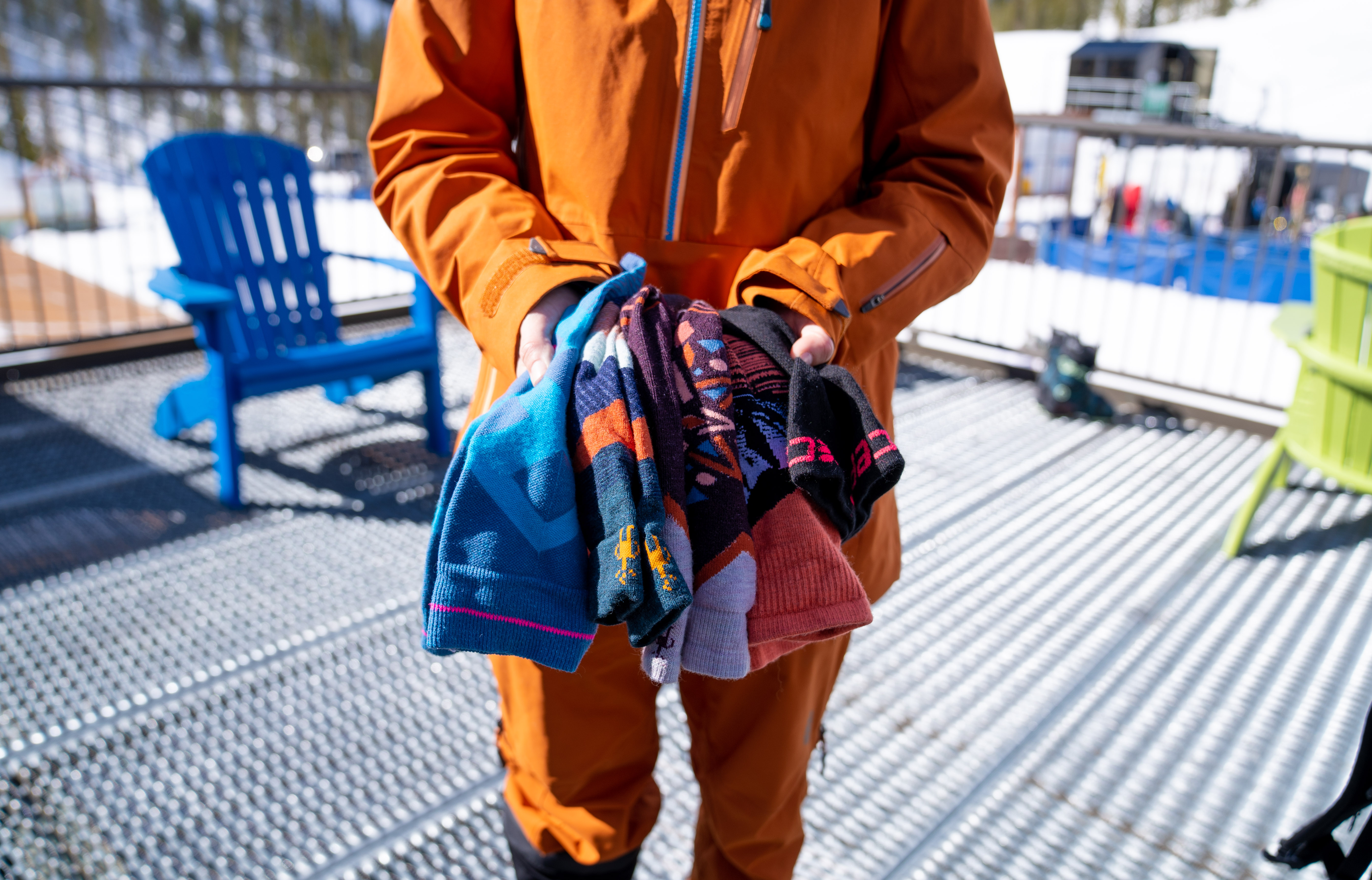
Our Testing Grounds
Our ski sock testing takes place across some of the most iconic and challenging winter terrain in North America. Based in Jackson, Wyoming, lead testers Chris Kassar and Ryan Kempfer spend most of the season chasing snow across the Tetons, then travel widely through Colorado, Utah, and Canada to pursue their ski dreams and push gear to its limits. From deep backcountry tours and storm days at the resort to long road trips packed with powder hunting, they’ve tested socks in every imaginable condition — from bitter cold mornings to wet, heavy spring slush.
Each season, our team skis hundreds of hours in varied terrain and temperatures to see how every sock performs in real life — not just in the gear lab. These mountains are our testing ground, and the experiences here shape every recommendation in this guide.

Our Testing Process
While testing ski socks, we focus on the textile blend, warmth, breathability, targeted cushion, height, stretch, elasticity, durability, compression fit, graduated medical-grade compression, softness, fit, heel cup, Achilles, hem, toe box, targeted mesh zones, seams, odor resistance, cleanness of threads, colors and pattern, density, and sustainability.
We consider sport-specific and gender-specific models, too. And we narrow down the most popular, novel, and legacy designs. We test socks at the resort and in the backcountry and during on-snow workouts, as well as across genders, to qualify the product claims.
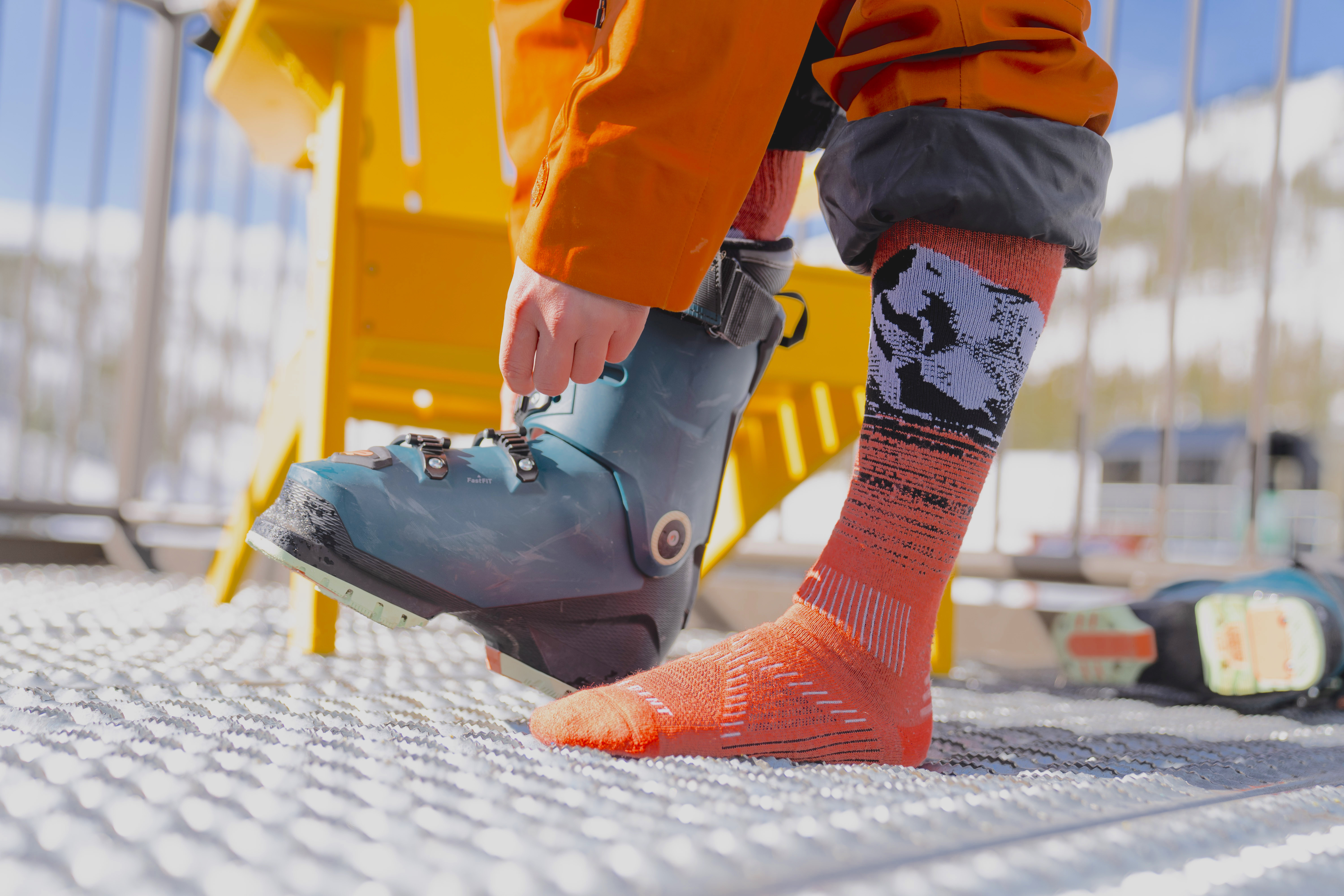
How We Rate Ski Socks
We score each ski sock on a 1 to 10 scale using four key performance categories: comfort, warmth, fit, and durability. These ratings reflect months of testing in real-world conditions across the Tetons, Colorado, Utah, and Canada.
Comfort captures how the sock feels throughout long ski days, from lift rides to backcountry climbs, factoring in softness, breathability, and how well it manages moisture against the skin.
Warmth measures insulation and temperature regulation in varying conditions, including frigid mornings and wet, heavy snow.
Fit evaluates how well the sock stays in place inside boots, its stretch and support, and whether it prevents bunching, slipping, or pressure points.
Durability reflects long-term performance — how well the fabric resists pilling, compression loss, and wear after repeated days of skiing and washing.
The overall score represents our complete verdict based on field performance rather than a simple average. Each rating comes from extensive side-by-side comparisons and input from multiple testers across diverse mountain conditions.
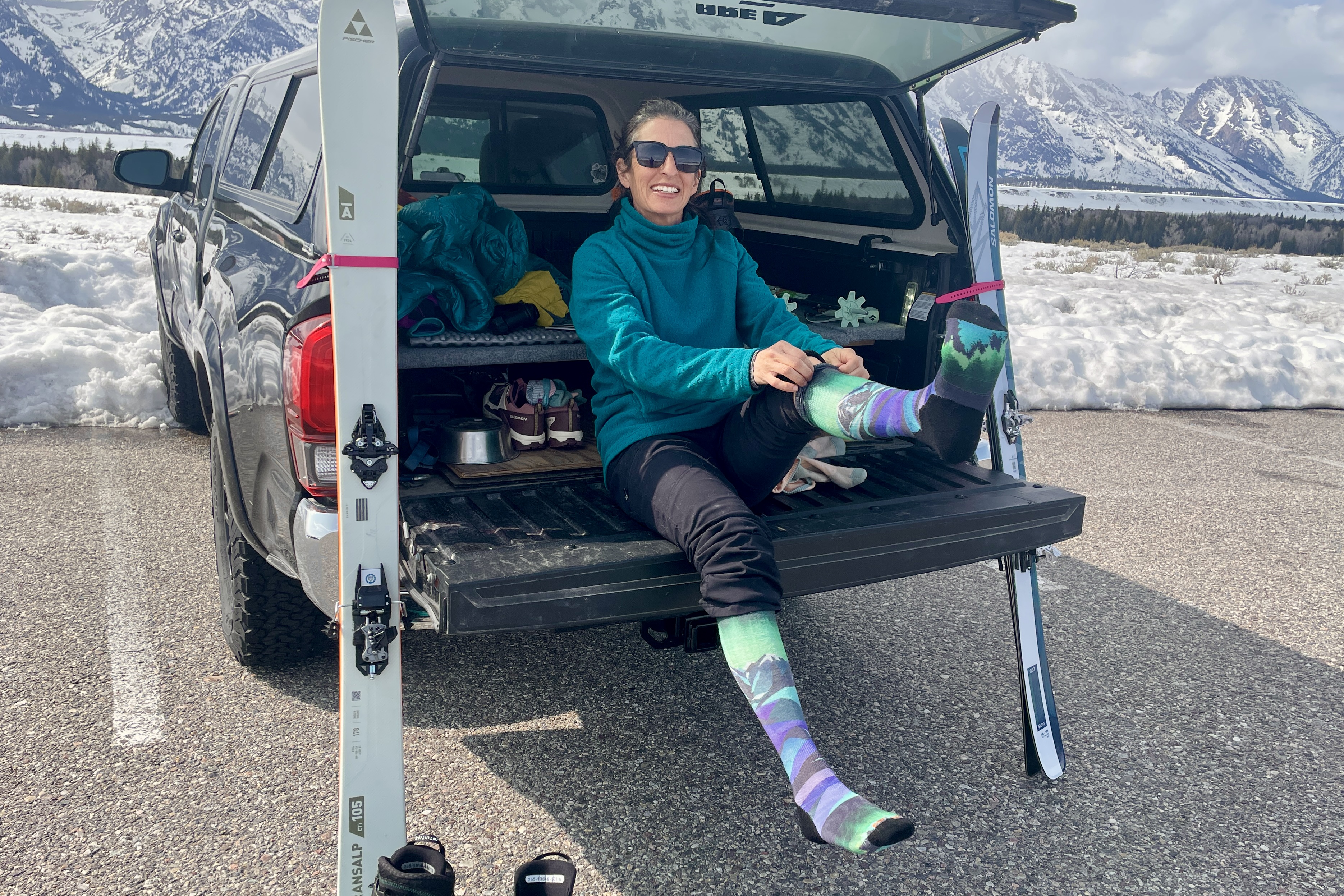
Buyer’s Guide: How to Choose the Best Ski Socks
Materials
Wondering if you should invest in wool or synthetic? When it comes to ski socks, a blend of both is best. But there are still dozens of types of fabrics out there. Our favorite socks in testing all had a blend of merino wool, nylon (or polyamide nylon), and elastane or Lycra spandex for stretch.
To learn more about how wool and synthetic materials differ, read below.
Wool
When shopping for ski and snowboard socks, you will often see “merino wool” on the packaging. merino wool is derived from merino sheep, mostly found in Australia and New Zealand. Because of its softness and natural ability to wick moisture and retain heat, it is used in most ski and snowboard socks, as well as winter base layers.
How does merino wool differ from normal wool? For starters, it is much thinner than normal wool, allowing it to be more moisture wicking and odor resistant than the latter. This thinness makes it useful for those garments closest to your skin — like ski and snowboard socks. One of our favorites using a lot of merino wool is the Darn Tough Over the Calf Midweight Socks.
If you are weary of purchasing wool socks due to ethical or sustainability issues, be sure to check out the ski socks’ brand’s resourcing initiatives. For example, Smartwool has partnered with ZQ merino, an organization that focuses on certifying manufactures and creating standards that end abuse in the merino supply chain.
For those looking for a ski sock mostly composed of merino wool, the Smartwool Ski Targeted Cushion OTC Socks is a great choice for those wanting all the benefits of natural fibers.
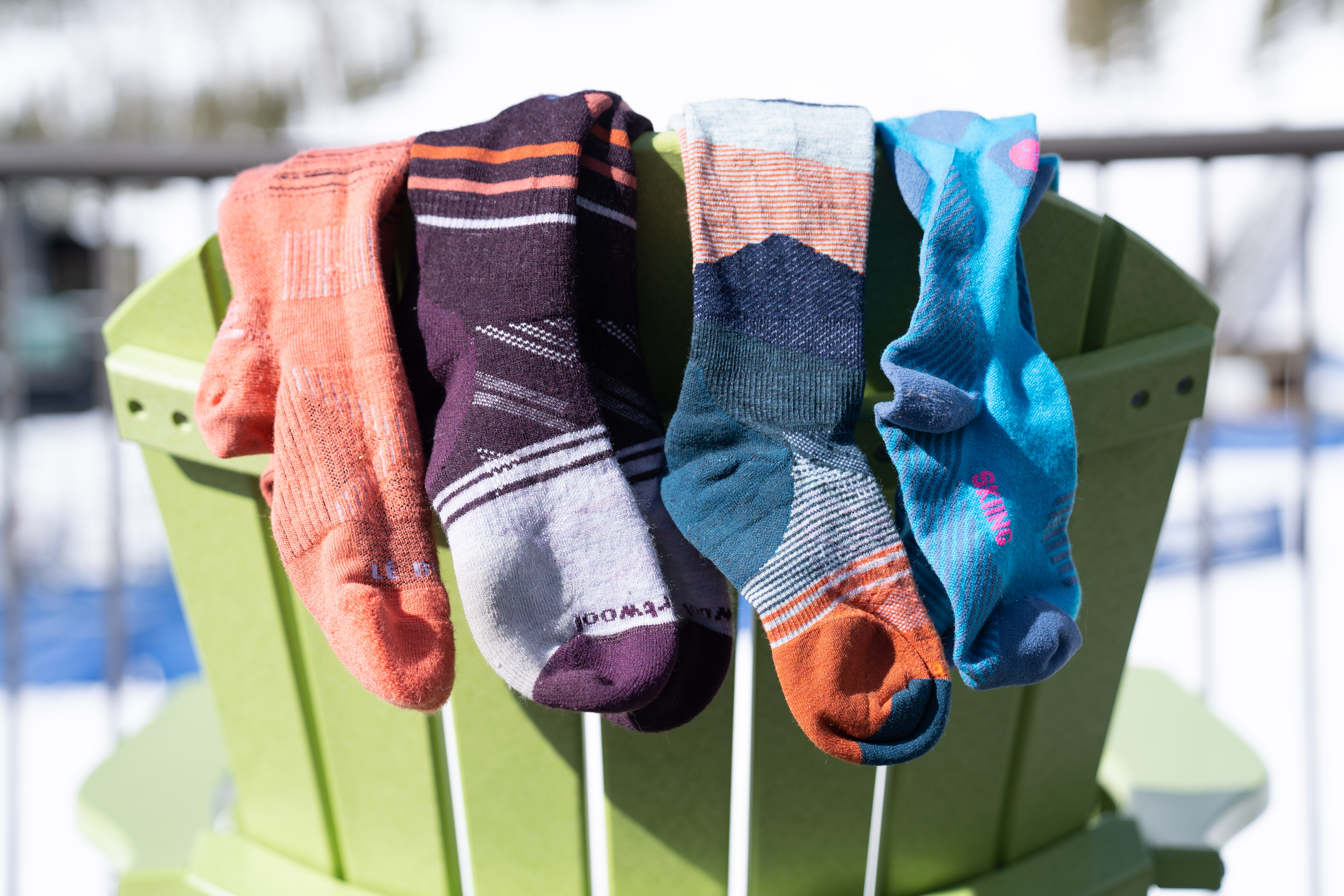
Synthetic
Most ski socks are engineered with a mixture of natural and synthetic materials. While wool socks tend to be the choice material for skiing and snowboarding socks, synthetic fabrics can perform just as well on the slopes in insulating, moisture wicking and comfort abilities.
Synthetic materials are often a combination of polyester, nylon, and spandex fabrics. They perform well in breathability and moisture prevention, but it is important to note that they tend to take longer to dry than wool after becoming wet.
We believe that synthetic and wool materials function at their best when combined, which is why you will see that a majority of the products listed in this guide use both materials in complementary pairs. With 66% of its fabrics being merino Wool and 34% being synthetic, the FITS Light Ski Sierra is a prime example of how successful the relationship of these materials can be.
Regardless of what fabric you choose for your ski and snowboard socks, always turn away from cotton. It lacks the heat-retention and moisture-wicking abilities that wool and synthetic materials provide.
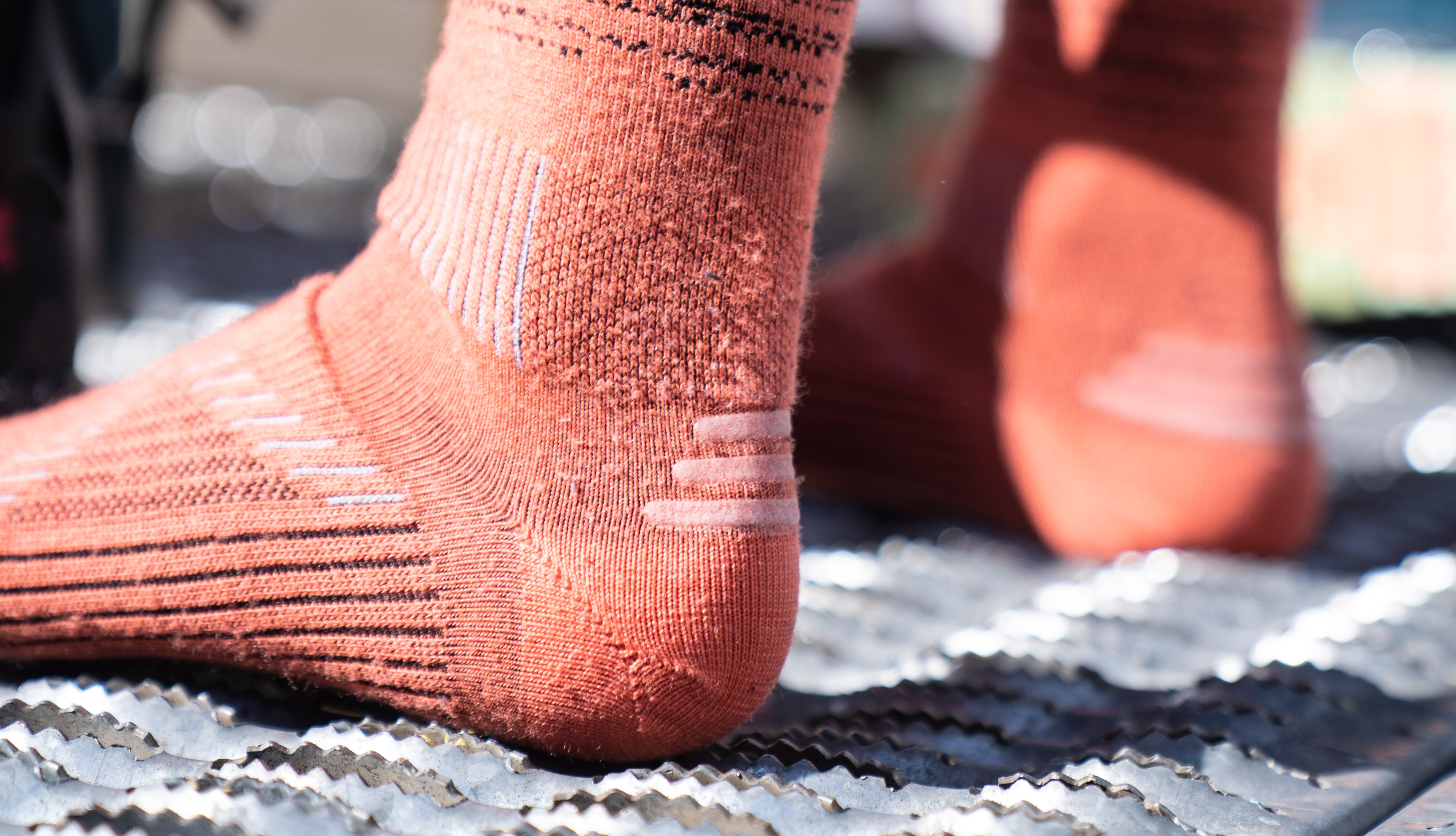
Ski Sock Construction
The other important element to look for in ski socks is not just the fabric itself, but how it’s woven. Are there flatlock seams, seamless toes, heel lock features, reinforced zones, or extra padding or cushioning in the shins? All of these elements can heavily impact how well you enjoy your day on the mountain. We think the best ski socks are those you don’t notice too much in your boots, i.e, they keep your feet at a comfortable temperature without any feeling of itchiness, lumps and hot spots.
Many ski and snowboard socks are anatomically constructed, meaning they are designed to fit the contours and shapes of the user’s lower legs. Anatomically designed ski socks tend to be labeled “Left” and “Right” to allow the most accurate fit. An example of this purposeful design element and application can be found in the Icebreaker Merino Ski+ Light Over the Calf Socks.
With ski socks it’s really all in the details. Ski socks like the Le Bent Core Light Snow Sock with heel and calf lock features stood out to us due to their purposeful engineering and useful applications.
When deciding on a ski or snowboard sock it is important to consider all of these design elements and your own personal preference. Do you prefer a more bare feel to your socks, or do you want your feet to feel like they are fully cushioned? To learn more about these construction elements, keep reading below.
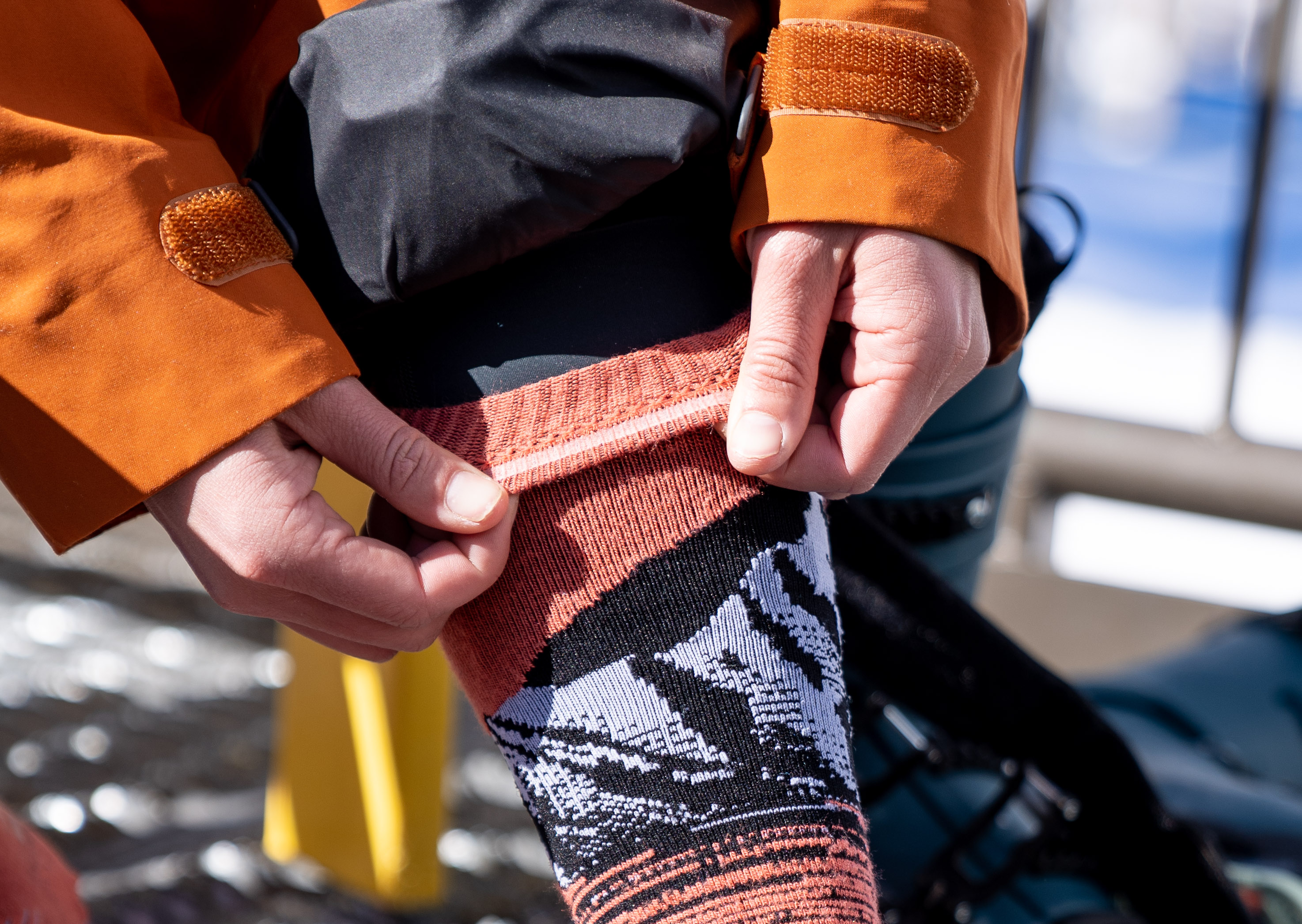
Ski Sock Length
When thinking about your skiing and snowboarding socks, an important construction aspect to consider is length. Most ski socks are designed in longer styles that reach above the calf right below the knee. The longer the sock, the more insulated your feet and legs can stay inside your boots.
Your ski and snowboard socks are ultimately your second skin when you are shredding, so it is important to note that the longer the sock, the more protected you are. If you get a ski sock that is an incorrect length for you, you may fall victim to shin bang — a painful injury caused by your ski boots and socks creating pressure points on your shins while skiing.
On the longer end of the scale, we preferred the Smartwool Targeted Cushion Over The Calf Sock. Those that prefer a more exact fit at or below the calf should consider the Dissent GFX Compression Hybrid sock.
Ultimately, sock fit in terms of length is dependent on your leg height, so it is recommended you try on socks with your boots before you buy.
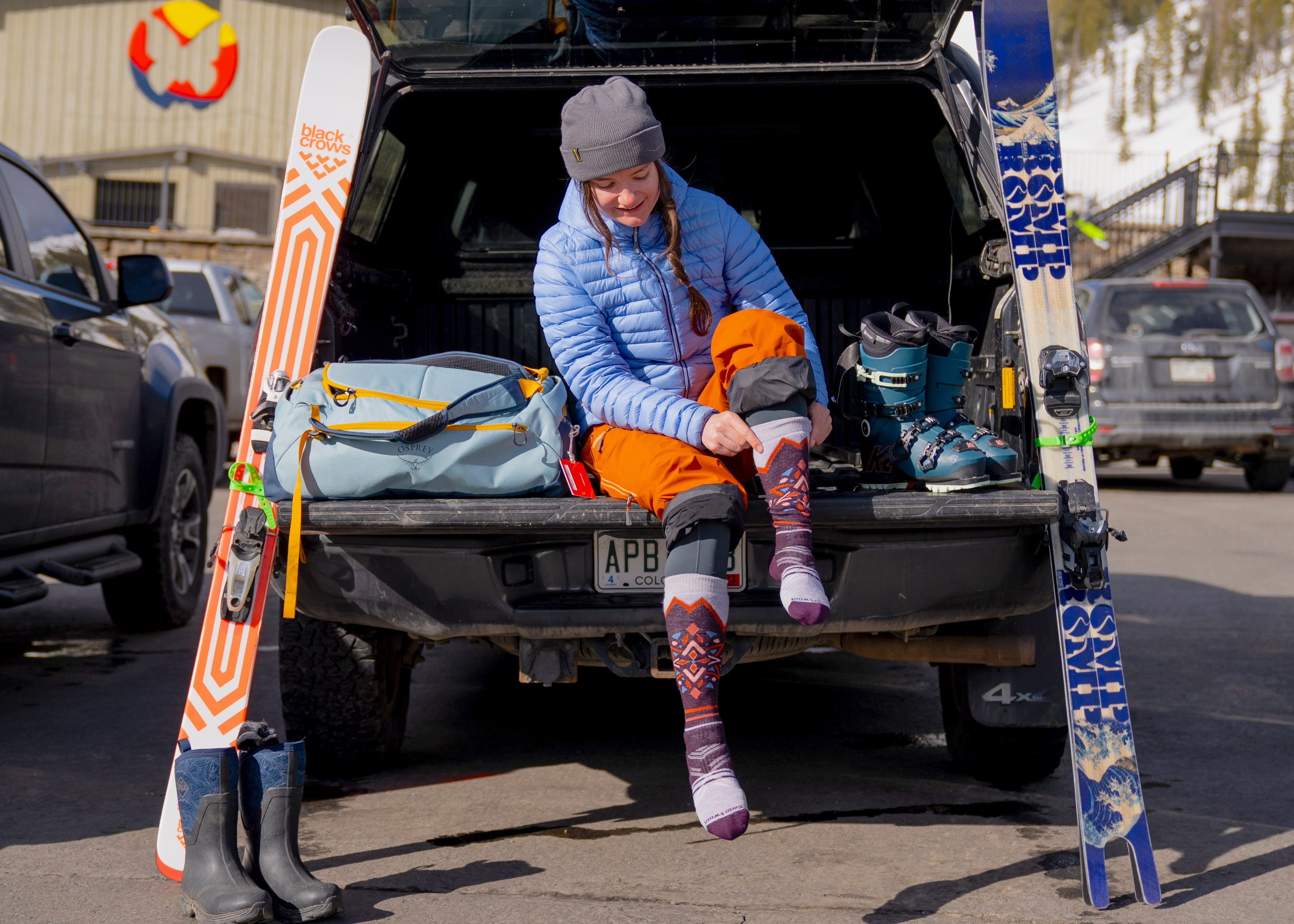
Thickness & Warmth
If you are mainly touring, you’ll probably want a lighter ski or snowboard sock that won’t rub or slide around, and that wicks sweat super well. If you ski in very cold climates, you may want a midweight for warmth. In general, performance-oriented skiers often reach for a leaner sock that allows a more precise feel.
You’ll also want to consider how a sock fits within your boot — and make sure that the sock-boot combo is not too tight — this can play a role in circulation and heat management, too. If you run cold, you’ll also want to consider a midweight (or even heavily cushioned) sock. A boot-sock combination that is too loose can lead to foot cramping, hot spots and blistering, making for a less than ideal day on the mountain.
In our reviews above, we listed each sock’s type of thickness or weight: this refers to ultralight, lightweight, midweight, or heavyweight fabrics. We’ve also called out whether the socks have added cushioning.
In terms of weight, our editors (a mix of intermediate to expert skiers and snowboarders) all leaned toward preferring lighter to medium weight socks, such as the Smartwool Ski Full Cushion socks.
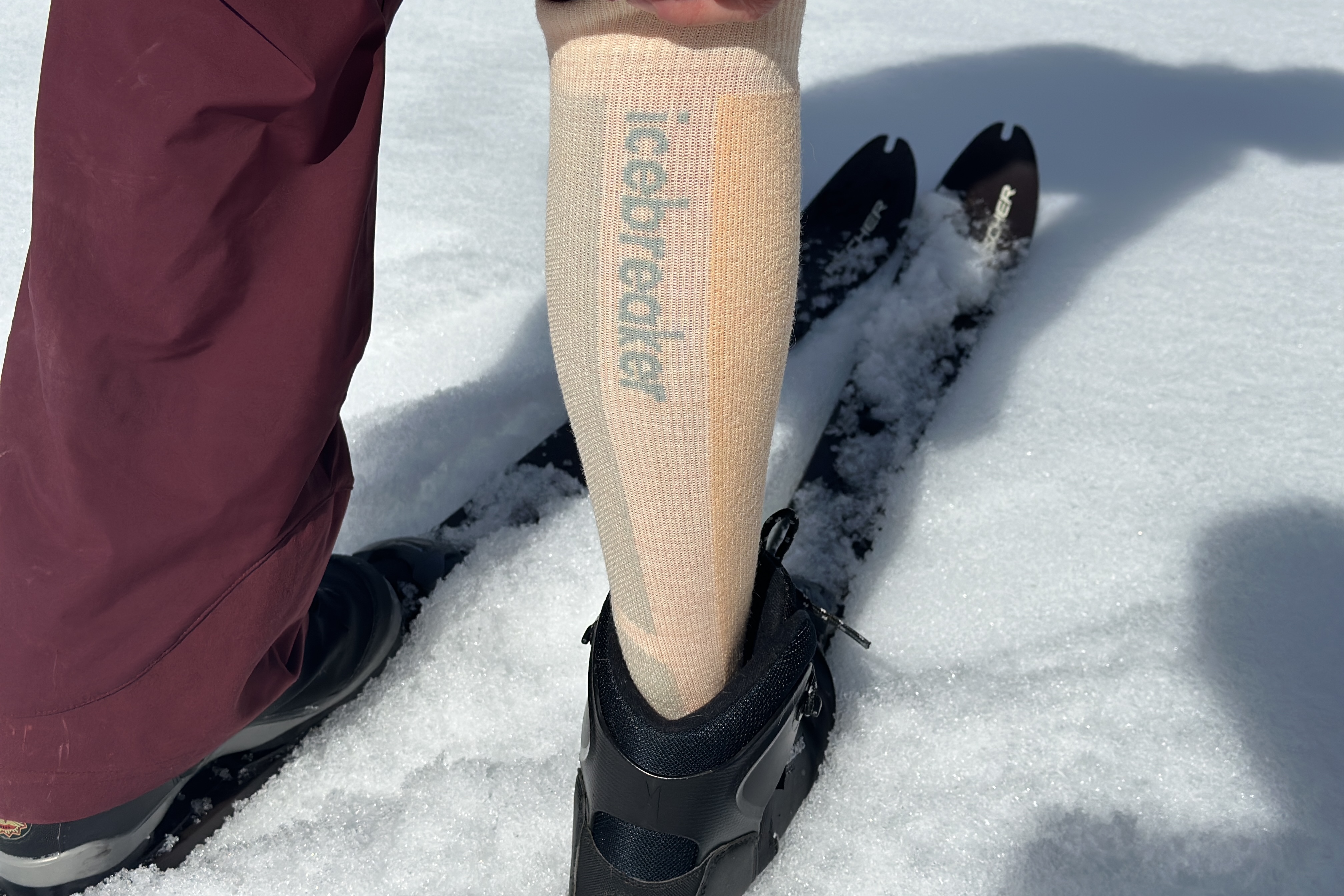
Cushion
As mentioned above, we carefully considered the cushioning of all the ski and snowboard socks we have listed in this guide. Cushioning refers to the parts of the sock that have been given added thickness to increase padding and comfort. Most often, you will find cushioning in the toes, heels, shins and sometimes soles of the socks.
Cushioning is a key element to consider in your ski or snowboard socks if you are seeking to protect your toes from blistering, the cold, or hot spots. There are three levels of cushioning, light, medium and heavy. You’ll want lighter cushioning if you crave a more responsive feel in your ski boots, or you may want medium to heavy style if you like the extra padding. If your ski boots are rentals or packed out from extended use, heavier cushioning in your ski socks might just be your best friends on the mountain.
Out of the socks we have listed in this guide our choice for lighter cushioning is the Icebreaker Merino Ski Light Over the Calf Socks. Our choice for medium cushion is the Darn Tough OTC Midweight Ski Socks. If you are looking for a ski or snowboard sock with no additional cushioning whatsoever, we recommend the paper thin Smartwool Zero Cushion.
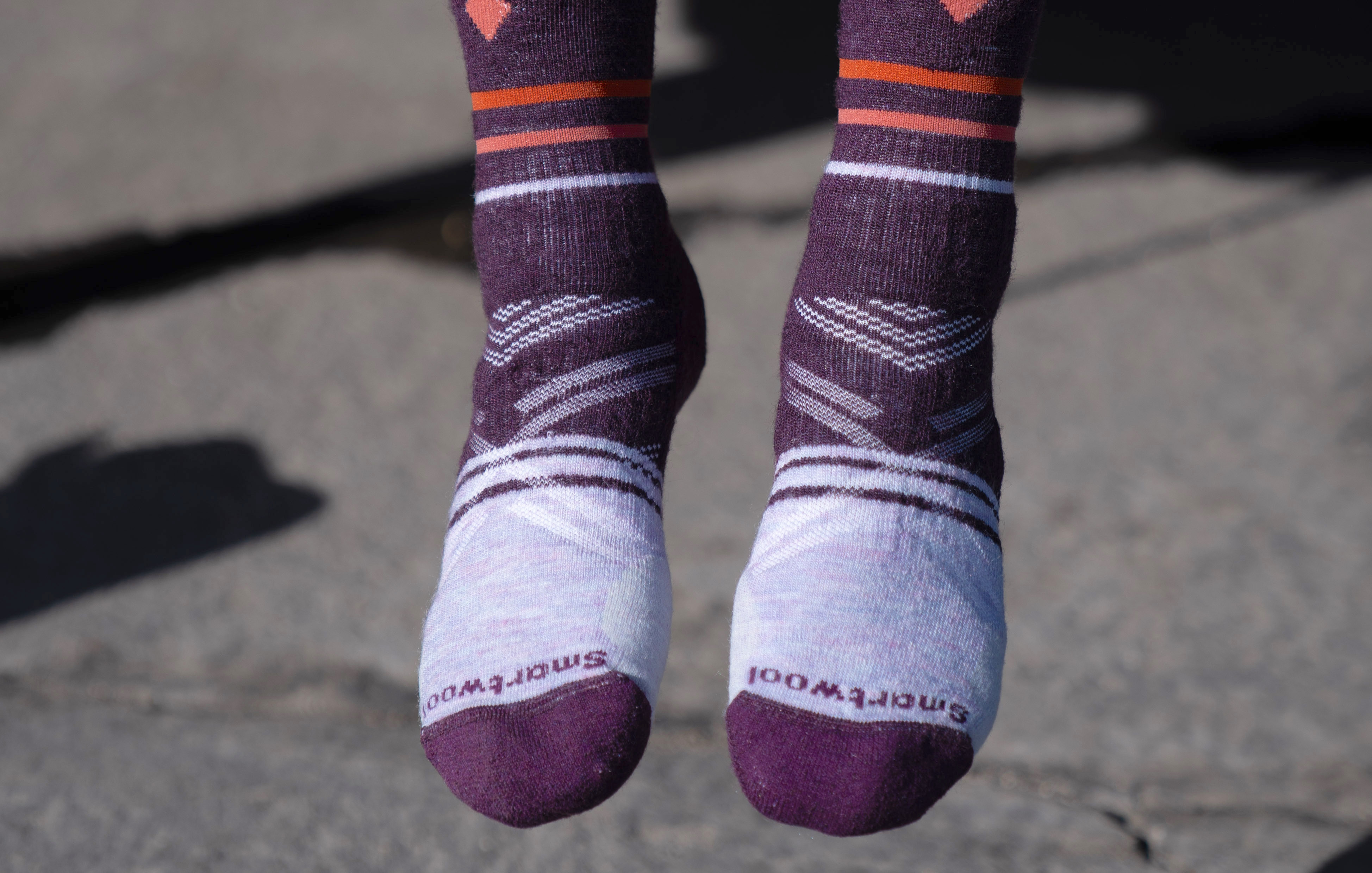
Ski Sock Fit
Perhaps the most important element of a ski sock is how it fits. Like we mentioned earlier, when you are skiing or snowboarding at the resort or in the deep backcountry, your socks should feel like a second skin. A well-fitting ski sock should adhere itself to your foot and leg without any unnecessary bunching, sliding or circulation prevention.
Most ski and snowboard socks are anatomically designed, meaning they are customized to fit the contours of the leg, while also providing a certain level of arch support to prevent any sort of foot fatigue while you’re crushing the slopes. Furthermore, many ski socks have a heel lock feature, such as the FITS Light Ski Sierra, to hinder any blisters and improve stability within the ski boot.
When thinking about fit in a ski or snowboard sock, it is imperative to consider the type of ski boot you will be pairing with it. Do you have a tight racing style boot that requires a high performance fit in a ski sock? Or do you have a pair of spacious snowboard boots that could use the extra arch support from a heel lock feature?
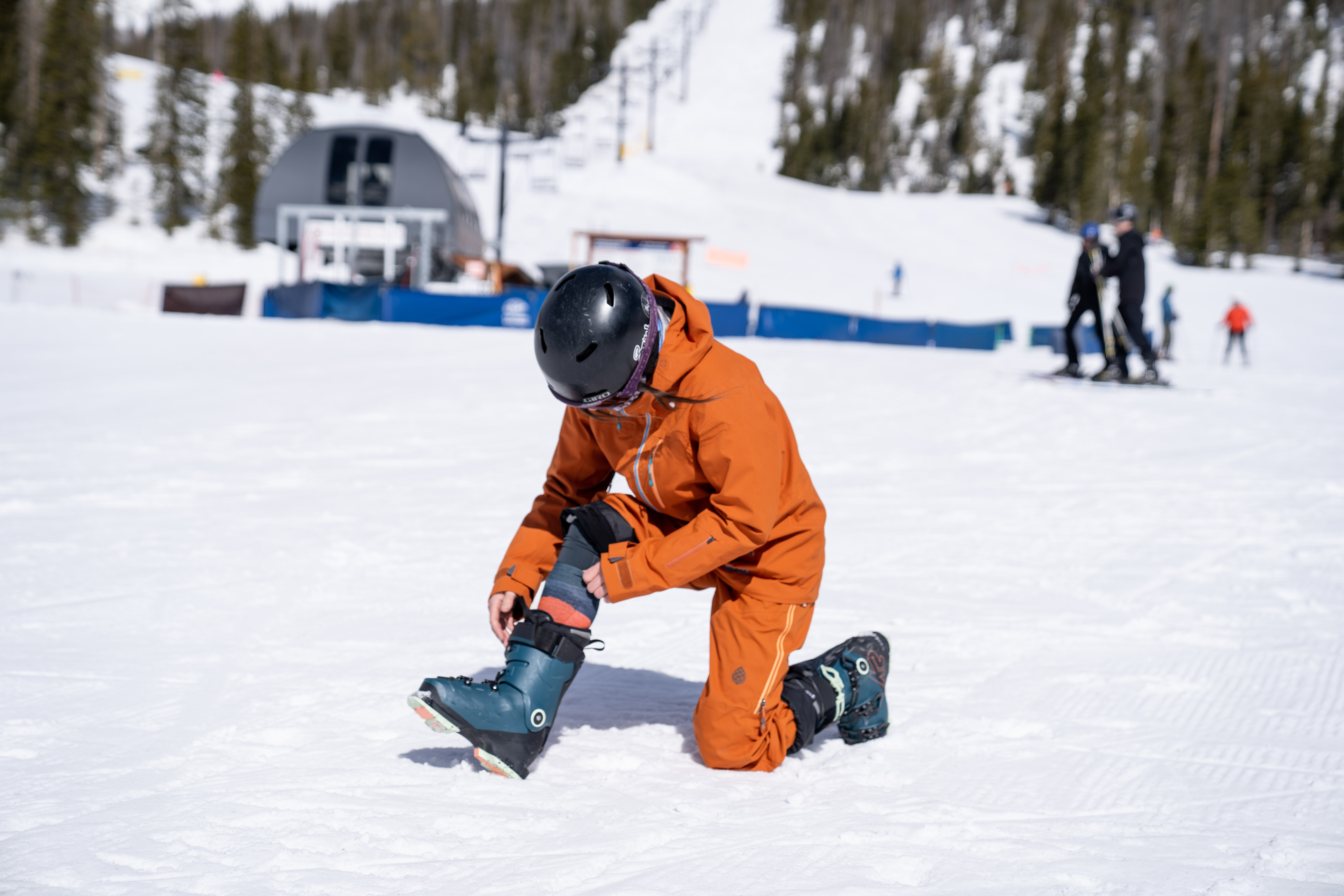
Ski Socks vs. Snowboard Socks
Some brands, like Darn Tough, make no distinction between skiing and snowboarding in its sock design. The designers posit that various sock thicknesses, padding, and height can work for either skiing or snowboarding boots, depending on personal preference and how your boots fit. Skiers or riders with tighter boots are often best suited to thinner socks. Those with a more generous boot fit have more room for thicker, more insulating, and more padded or protective socks.
Other brands, like Smartwool, strategically place padding in different zones for ski and snowboard socks. The brand’s ski socks come in zero cushion for vacuum-tight ski boots. The targeted cushion offers more comfort and protection without adding bulk. And the full cushion versions are best for higher-volume or more packed out ski boots. Smartwool’s snowboard socks, on the other hand, come in targeted cushion and full cushion, which are slightly thicker than the corresponding ski version and sport more connected sections of padding. Fox River likewise adds more cushion in the snowboard socks while the designs lean more ultralight for ski socks.
We’ve extended the life of our packed-out ski boots for an entire season by switching from a typical zero-cushion ski sock to a fully cushioned snowboard sock to help fill in the additional volume. In general, it’s great to try a few different pairs of snow socks with various padding to dial in your boot fit and warmth requirements for different days.
Bottom line: A snow sock that matches your boot volume and fit, padding preference, and insulation needs will be more beneficial than focusing on whether it’s labeled as a ski or snowboard sock. That said, following labels is an excellent start point for finding your first technical pair of snowsports socks.
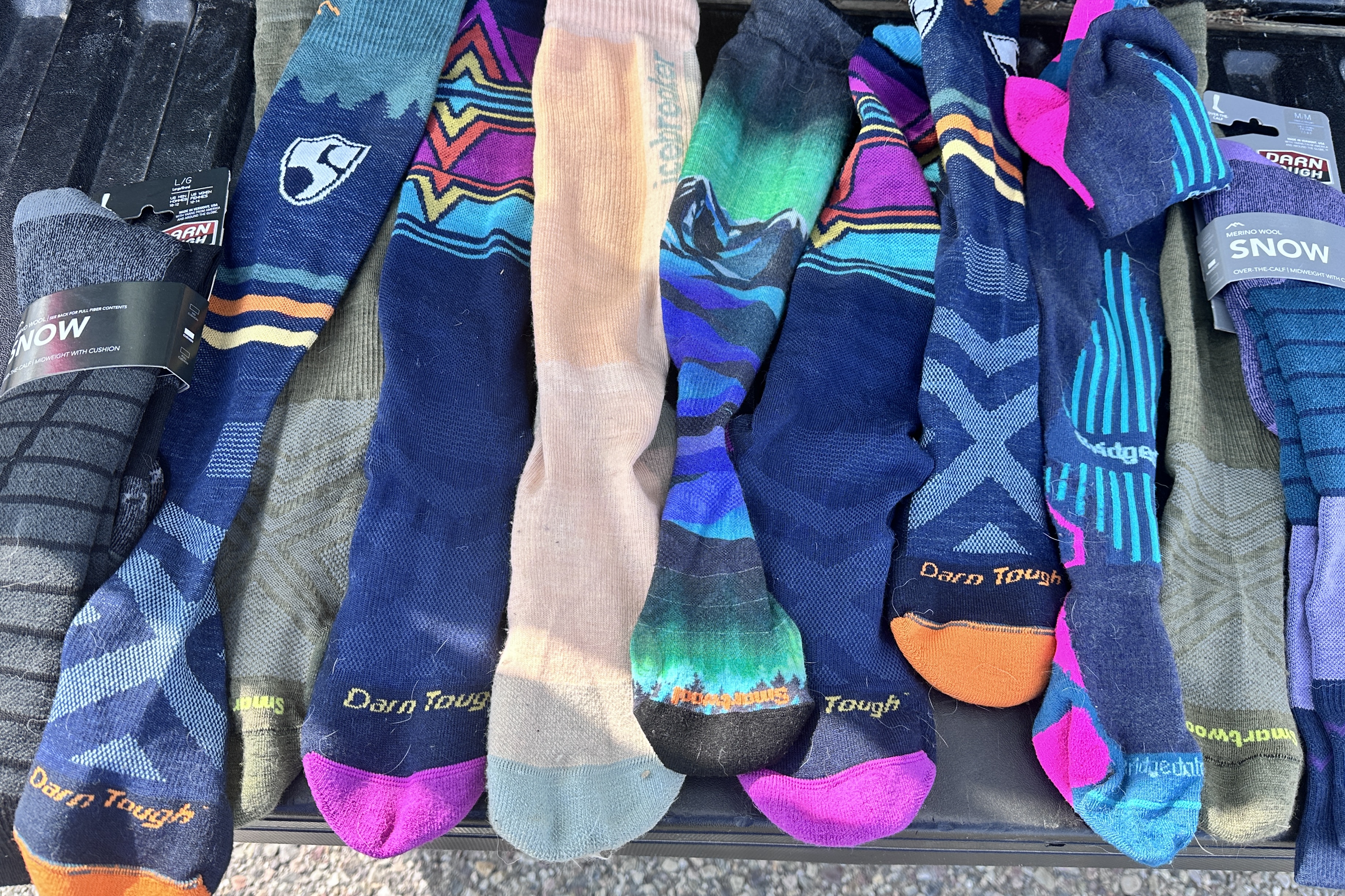
Men’s Ski Socks vs. Women’s Ski Socks
Many of the socks in this guide, like the Fox River Bootfitter Elite, come in both Men’s and Women’s versions. Le Bent’s Cody Townsend & Elyse Saugstad Pro Series Zero Cushion Socks also split a great sock into men’s and women’s iterations. At first glance, it’s tough to tell them apart, aside from the colors and size runs. But men and women tend to have different enough foot shapes to justify separate sock shapes. We asked designers at Smartwool and Fox River for more details.
According to Smartwool, women tend to have narrower feet that taper more toward the heel than men’s feet, so women’s-specific socks have an overall narrower profile and smaller heel volume. Fox River uses an entirely different machine for women’s socks that allows them to weave a smaller, more precise-fitting sock. That doesn’t mean women’s socks are just for women, though. Anybody with a relatively narrow foot and heel could benefit from a women’s sock to improve sock fit.
In addition, Smartwool found through thermal body mapping that men’s and women’s feet sweat differently. So some of the brand’s socks have breathable zones placed in strategic locations, which differ between the men’s and women’s socks. This won’t make-or-break your ski day, but it’s worth noting if you tend to use your ski socks for other aerobic winter activities like trail running.
Some ski socks come in unisex sizing. That will work great for some folks and for some activities, but it won’t work for everyone — especially those whose foot shapes fall outside the norm. We’re partial to the best fitting socks we can get our hands on. That’s why we tend to pick men’s and women’s specific socks for skiing rather than more generic-fitting non-gendered socks, because, as Fox River says, “Skiing starts with your feet.”
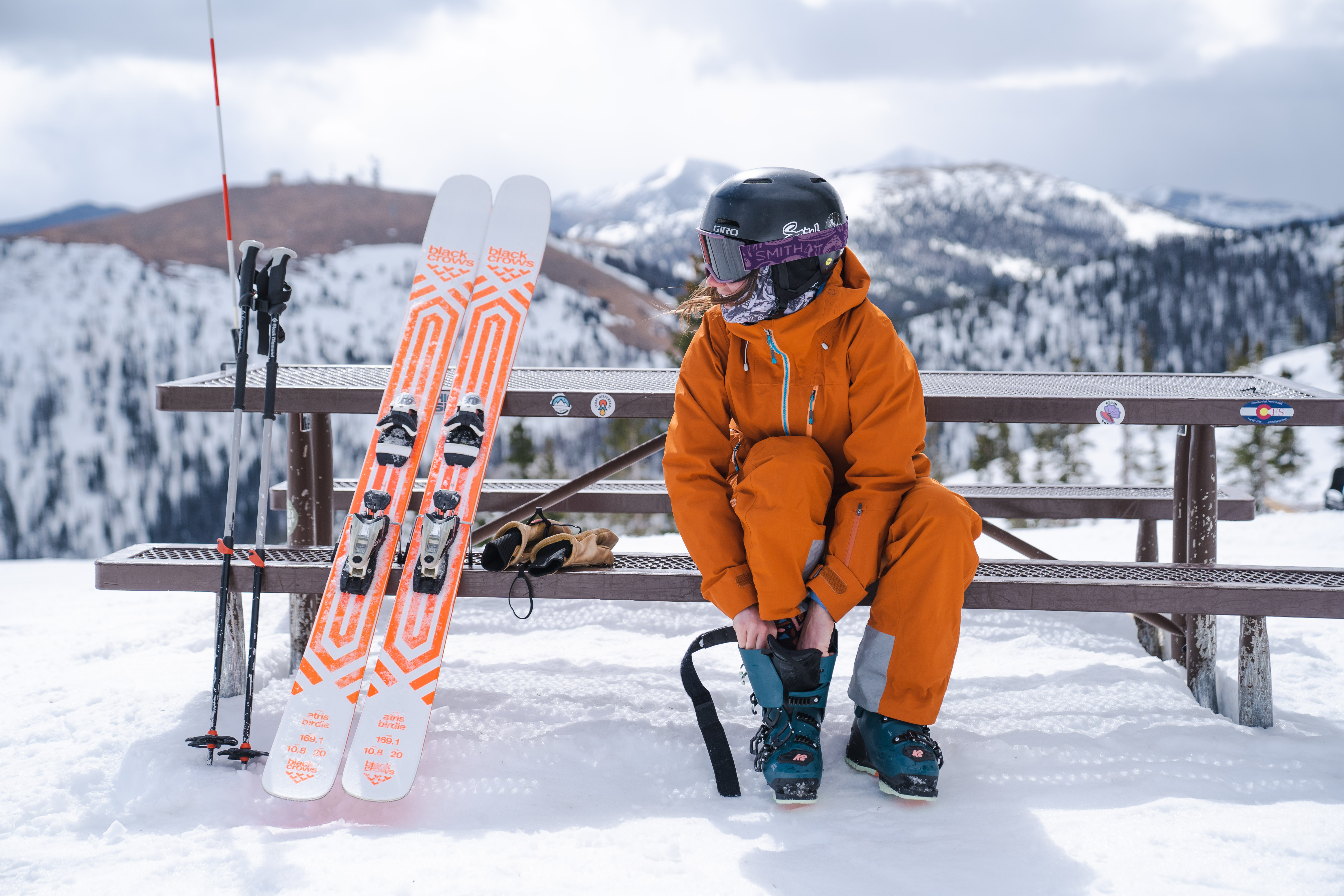
Elasticity
Depending on their materials and design, many ski and snowboard socks have a certain level of stretch, or lack thereof. In conjunction with fit, elasticity can affect how well your ski socks support your leg inside of a ski boot.
Elasticity is achieved through the use of specialized materials such as spandex or Lycra, a synthetic material that has exceptional stretch to it. When thinking about elasticity in ski socks, you’ll want the “Goldilocks,” i.e., not too stretchy and not too taut.
It is also important to consider the ability of your socks to “recover” after they have been used for extended periods of time. Do they return back to their normal shape, or do they remain stretched out? A sock designed with a proper amount of elasticity should recover without affecting long term use, but should also not be too loose that extra fabric bunches up in your boots.
With just the right amount of stretch without risking quality, the Le Bent Core Light Snow Sock and Wigwam Sirocco are our go-to picks in this category.
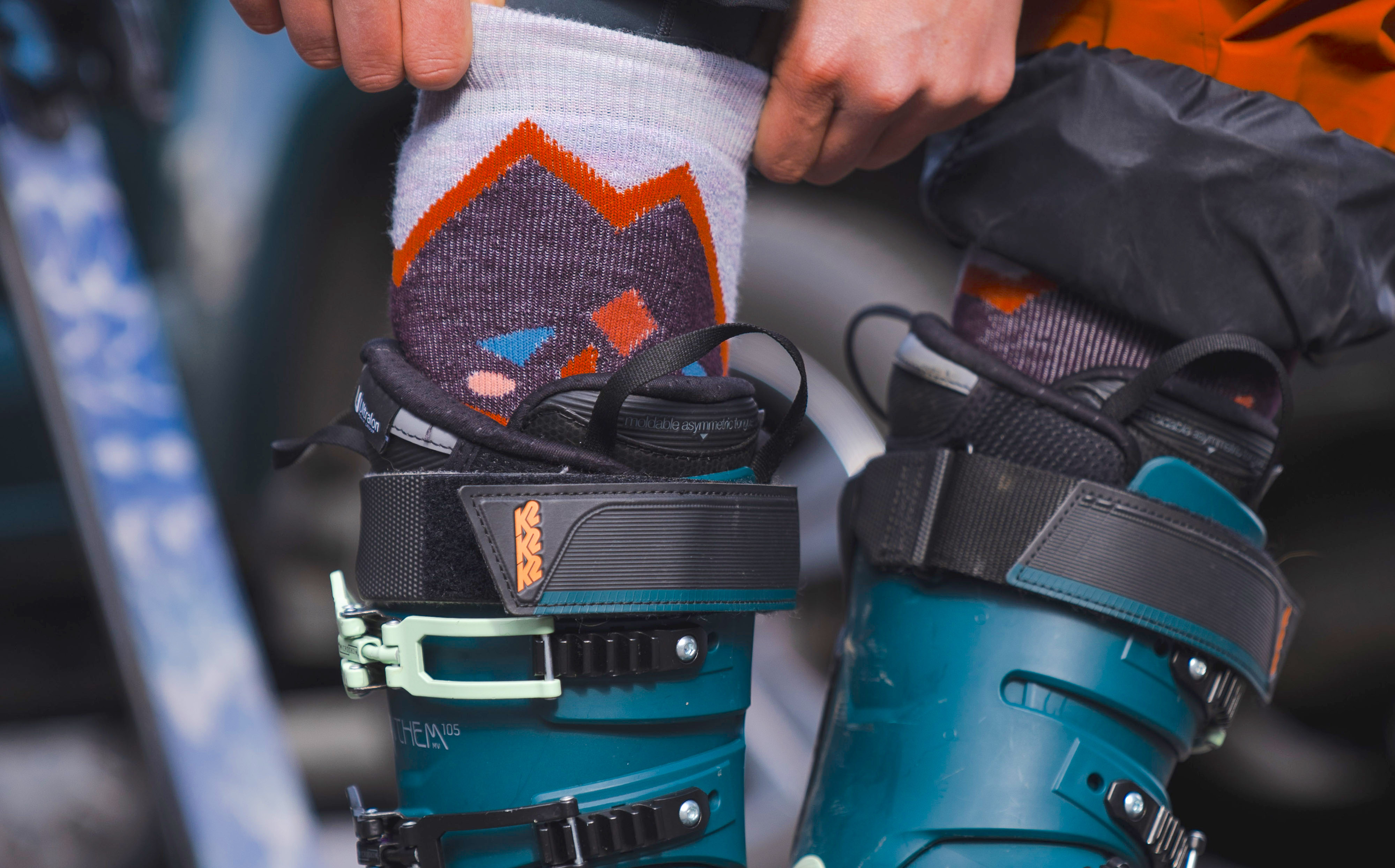
Breathability
Despite skiing or snowboarding in subzero temperatures, your feet can still get too hot and thus uncomfortably sweaty. Picking out ski socks designed with breathable fabrics is crucial to keeping your feet warm and dry, and preventing any blisters or smelly odor build up from sweat.
When you are spending several hours skiing, your body is generating an exuberant amount of energy, thus creating heat. Because your legs are doing a bulk of the work, your boots tend to be on the receiving end of this reaction. This heat will inevitably lead to sweat creation if you’re not wearing a technical pair of socks designed to prevent this from happening.
As mentioned above, merino wool and synthetic materials like nylon or polyester are experts at wicking away unwanted moisture and insulating heat. Breathable fabrics help regulate the temperature of your foot inside the boot, while also hindering any cold air or moisture from penetrating your feet.
When it comes to breathability, the Smartwool Ski Full Cushion and Targeted Cushion Over The Calf Sock performed the best followed closely by the Darn Tough OTC Midweight Ski Socks. Remember, avoid cotton at all costs. Once cotton is wet from sweat, you’re in for a bad time.
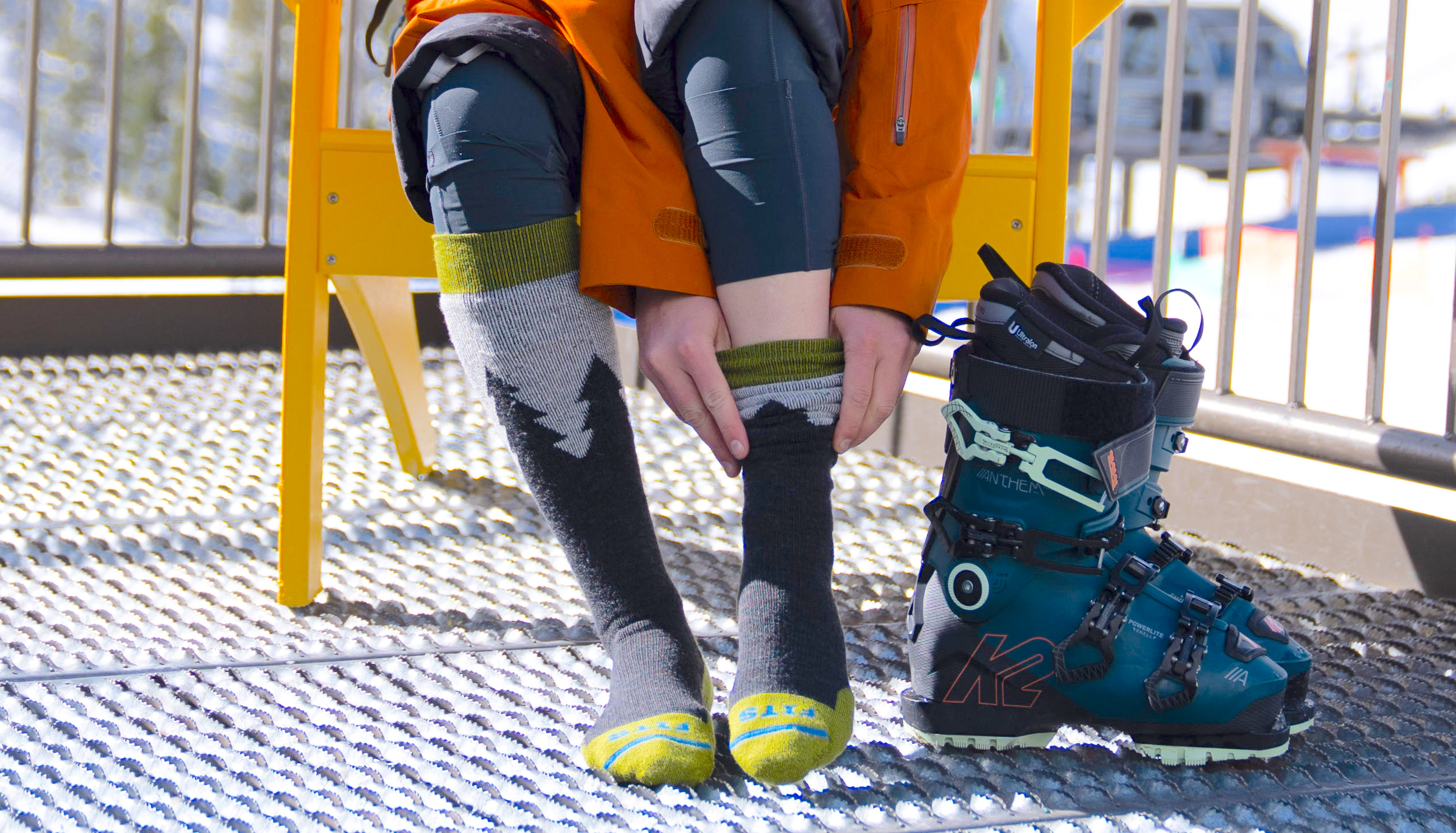
Odor Resistance
Let’s face it: socks eventually get stinky, and at some point, you’re going to need to wash them. But good ski socks will go a surprisingly long time before the odor crosses the line. Because socks are tasked with stinky work, companies typically go one of two routes that help to mitigate odors: if the blend includes wool, it has supplemental odor resistance. Or, the brand adds an odor-resistant treatment to the fabric.
Wool is tough if not impossible to beat when it comes to fending off stench. Between its ability to stay dry, natural wax on the wool fibers, and microscopically scaly structure, wool is naturally hostile to bacteria that feed off our glandular secretions and emit stench as a bi-product. The more wool in the sock, the better they resist stink.
Some products, especially those that don’t contain much or any wool, will use a treatment like Polygiene to fend off the growth of bacteria. While treatments vary, many of them — including Polygiene — utilize silver chloride, a naturally occurring salt that is hostile to microbes. Such treatments keep the fabric stink-free until the socks are really grungy.
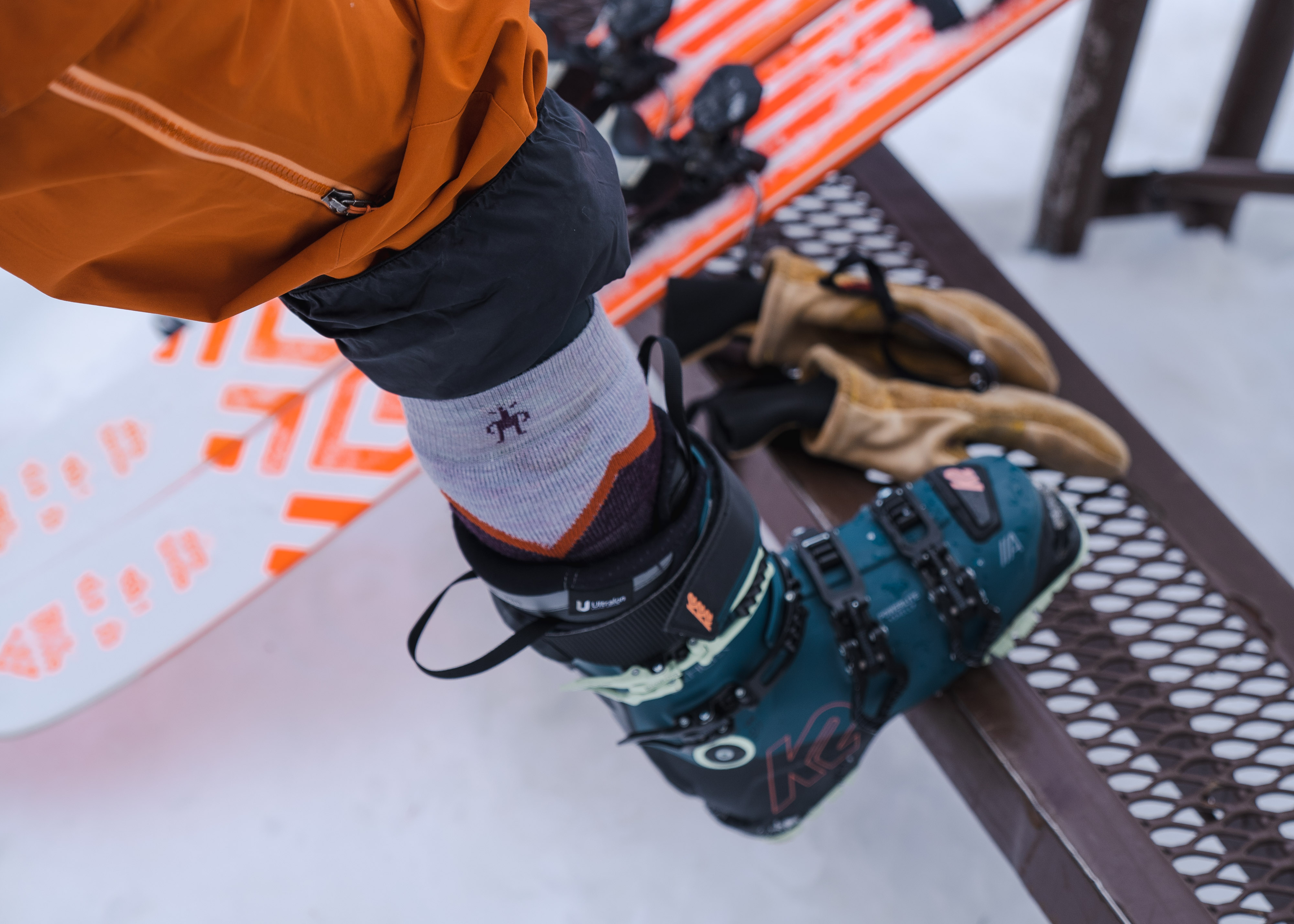
Durability
When you purchase a pair of ski or snowboard socks, remember that you are investing in your health, comfort and overall enjoyability on the mountain. This is why it is important to remember that the best socks will last the longest without a loss in quality or performance.
In thinking about durability, consider the setting and application your ski and snowboard socks will be used the most. Are you vacationing for a week to Colorado and need something that will work with rental boots? Or are you a daily skier, never missing a day on the resort?
If you are an aggressive skier or riding 80-100 days per season, it’d be counterintuitive to pick an ultralight sock due to its shorter lifespan. If you are looking to tour a few days here and there with a mix of resort skiing, consider a midweight sock that would apply itself well to either situation.
Ensure that if you plan on putting your socks through the wringer, you opt for ones with stronger (synthetic fibers), reinforced seams, or ones that hold up to lots of washes.
For durability, the Darn Tough Midweight won the most votes in a staff poll.

Compression
You’ll notice that a few of our picks on this list are labeled as “compression” socks. Commonly used by those in the medical and athletics industries, compression socks help improve circulation and reduce fatigue in the legs. They work by applying pressure to the feet and legs, thus preventing blood from pooling in the veins and improving overall blood flow. For these reasons and more, compression socks can be a great option for those looking for a similar effect in their ski and snowboard socks.
Compression can vary in ski and snowboard socks, from lighter to firmer pressure. They also tend to have a smaller pressure rating than medical grade compression socks. Users with circulation or muscle issues may benefit from a firmer compression sock, especially if they are skiing all day or hitting the skin track for a long tour. However, firm compression socks can be a bit of a challenge to get on, so definitely try before you buy.
Our top picks for ski and snowboard compression socks? The CEP Ski Touring Compression Socks and the Dissent GFX Compression Hybrid took the cake.
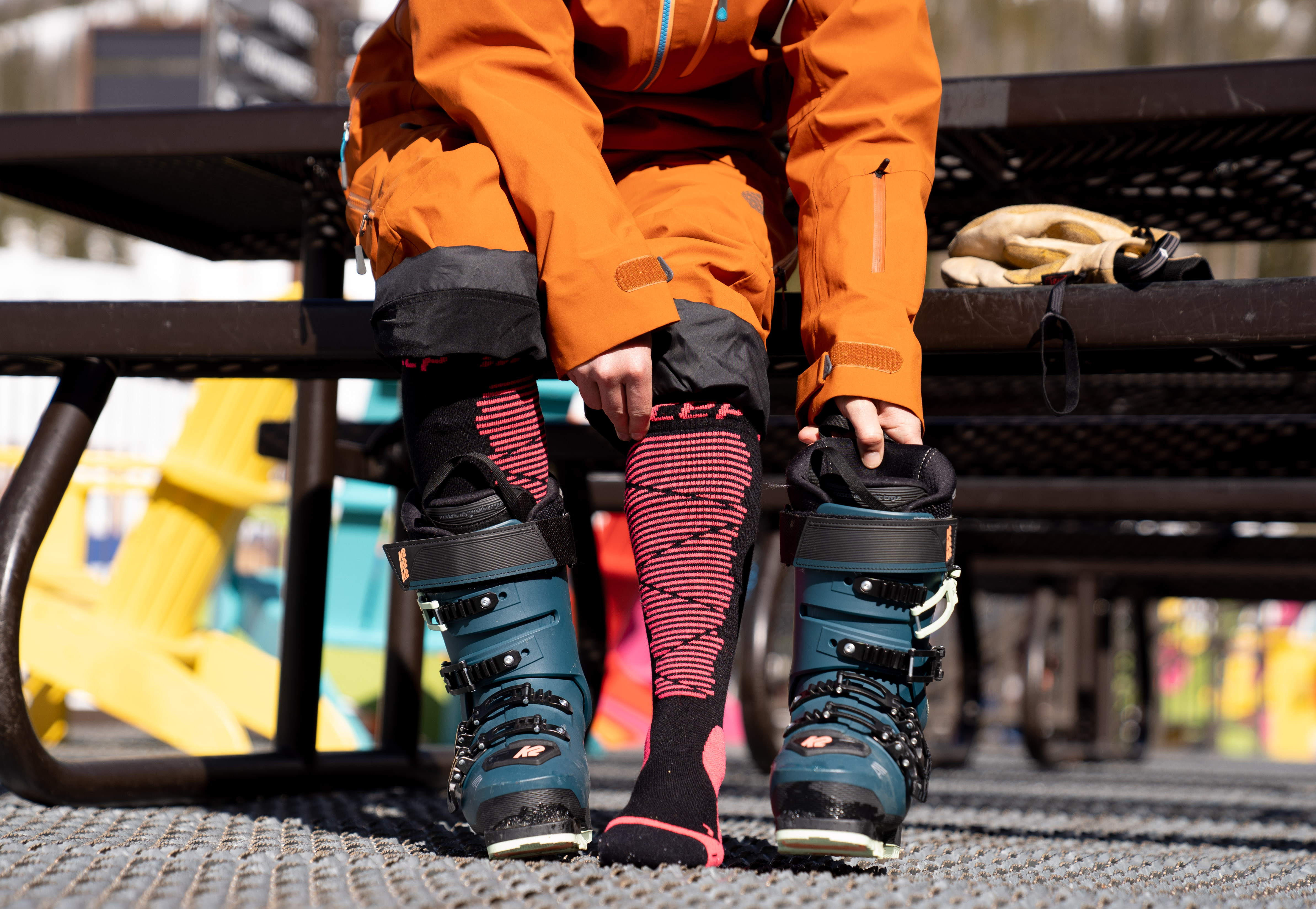
Warranty
Socks are high-wear gear — made out of fabric — and they won’t last forever. But high-quality socks often come with a solid warranty. Did your toes bust out prematurely? Before you toss them, it’s worth checking out, because a warranty could get you a replacement.
Manufacturer Defects
The ski socks in this guide come with a spectrum of warranties. Most brands, like Fox River, offer a baseline coverage: Your socks can be replaced if there is a manufacturer defect within a few years after purchase. Other brands extend the coverage for the life of the socks. “Manufacturer defects”’ usually doesn’t include general wear and tear. And some of our favorites, like the pricey Icebreaker’s Merino Ski+ Socks, only cover manufacturer defects for 12 months.
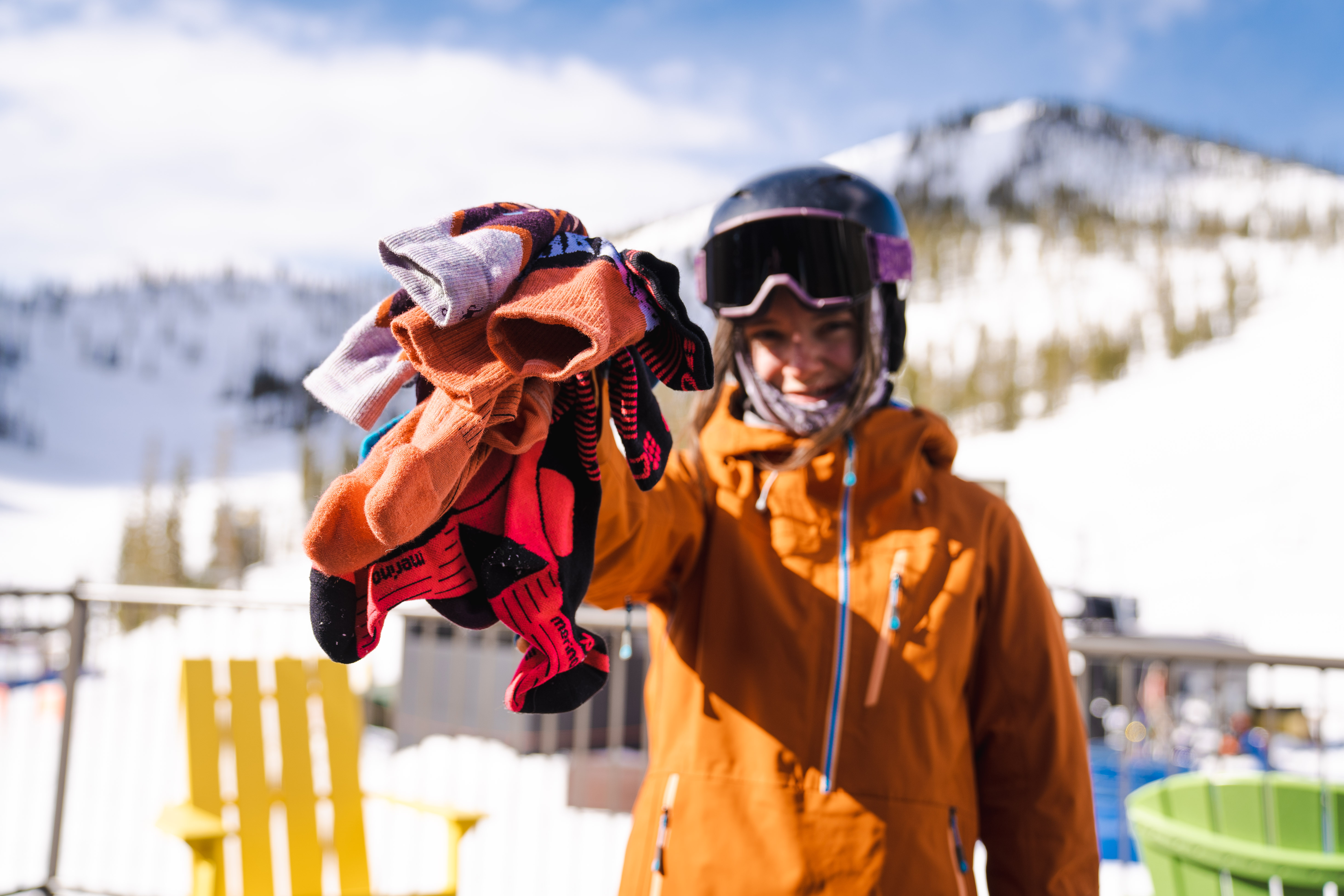
Complete Coverage, Limited Time
The next level up are warranties that completely cover the product for a limited time. Smartwool, for example, boasts what it calls the “Go Far. Feel Good. Guarantee,” which promises to replace your socks for any reason for two years from the point of purchase. This is often the sweet spot for a warranty — it shows that the company is confident that their socks will perform and survive a thrashing.
Many companies offer a more vague “100% satisfaction guarantee,” which should also cover sock blowouts, tears, defects, and a variety of other gripes. The actual replacement or refund criteria varies from company to company, though.
Total Coverage, Lifetime
Darn Tough reigns supreme in the warranty department with their “Unconditionally Guaranteed for Life” term. It states, “If these aren’t the longest lasting socks you’ve ever owned, you can return them to us for another pair. No receipt needed, just the pair in question.” That’s why many of our gear testers have relied on Darn Toughs for years.
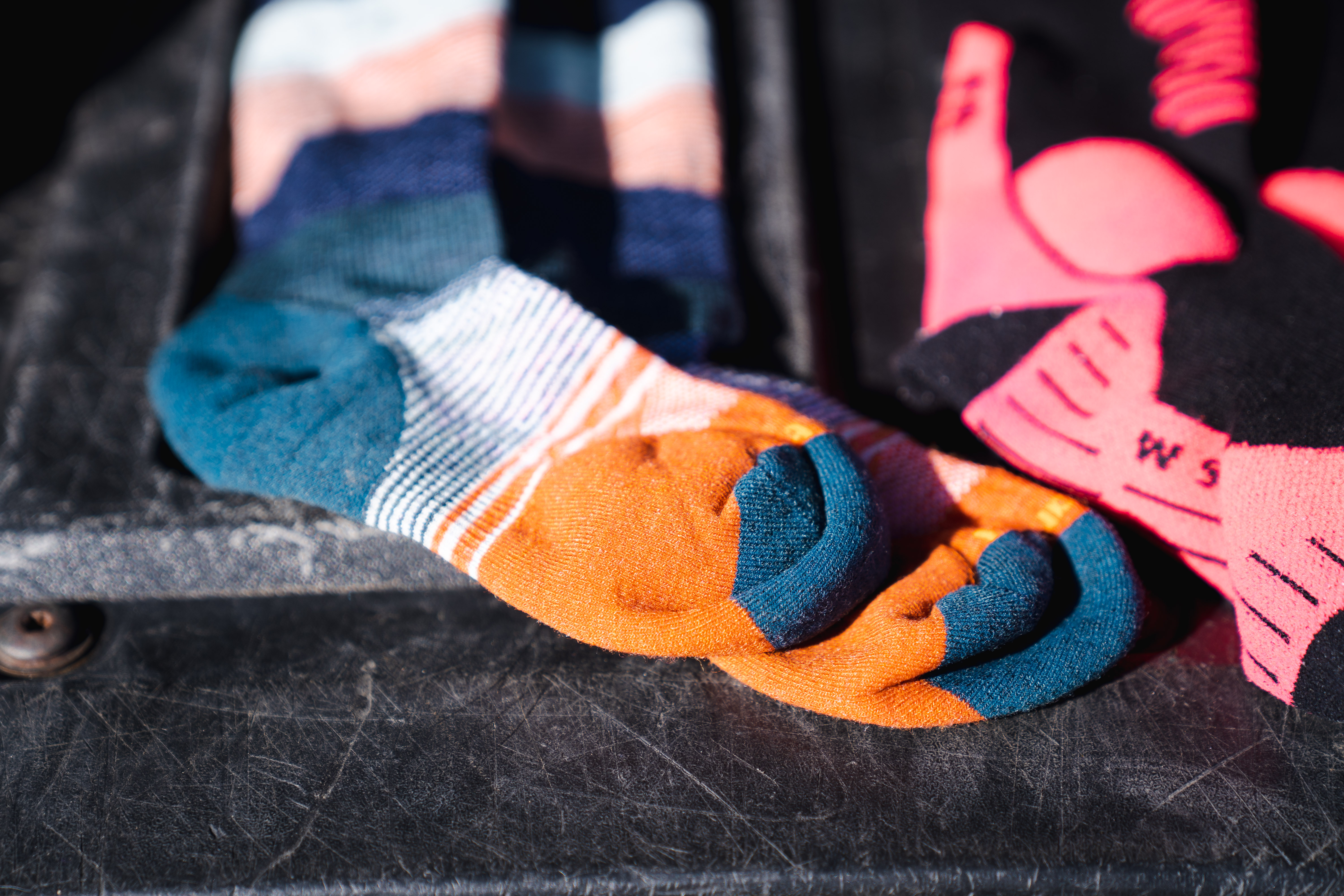
How to Care for Ski Socks
Taking care of your socks isn’t rocket science. But a little bit of extra care and attention can greatly extend the lifespan and performance of your favorite socks. Haven’t checked the website’s care guide? There’s a good chance you’re washing your socks wrong. Some of us certainly have.
Most companies urge a simple routine: Wash your socks in cold or cool water (less than 90 degrees F) with your typical detergent. Skip the dryer and hang them to dry instead. That way, they won’t shrink or get stretched out from heat or mechanical tumbling. It may seem obvious, but never iron your socks, and skip the bleach. The disclaimer here is that you should check your specific product’s care instructions, because different material blends require slightly different care.
When it comes to storing, especially for garments with wool, it’s best to fold them rather than hang them or stuff them inside one another. This helps extend the socks’ elasticity. Stretched out socks are a bummer.
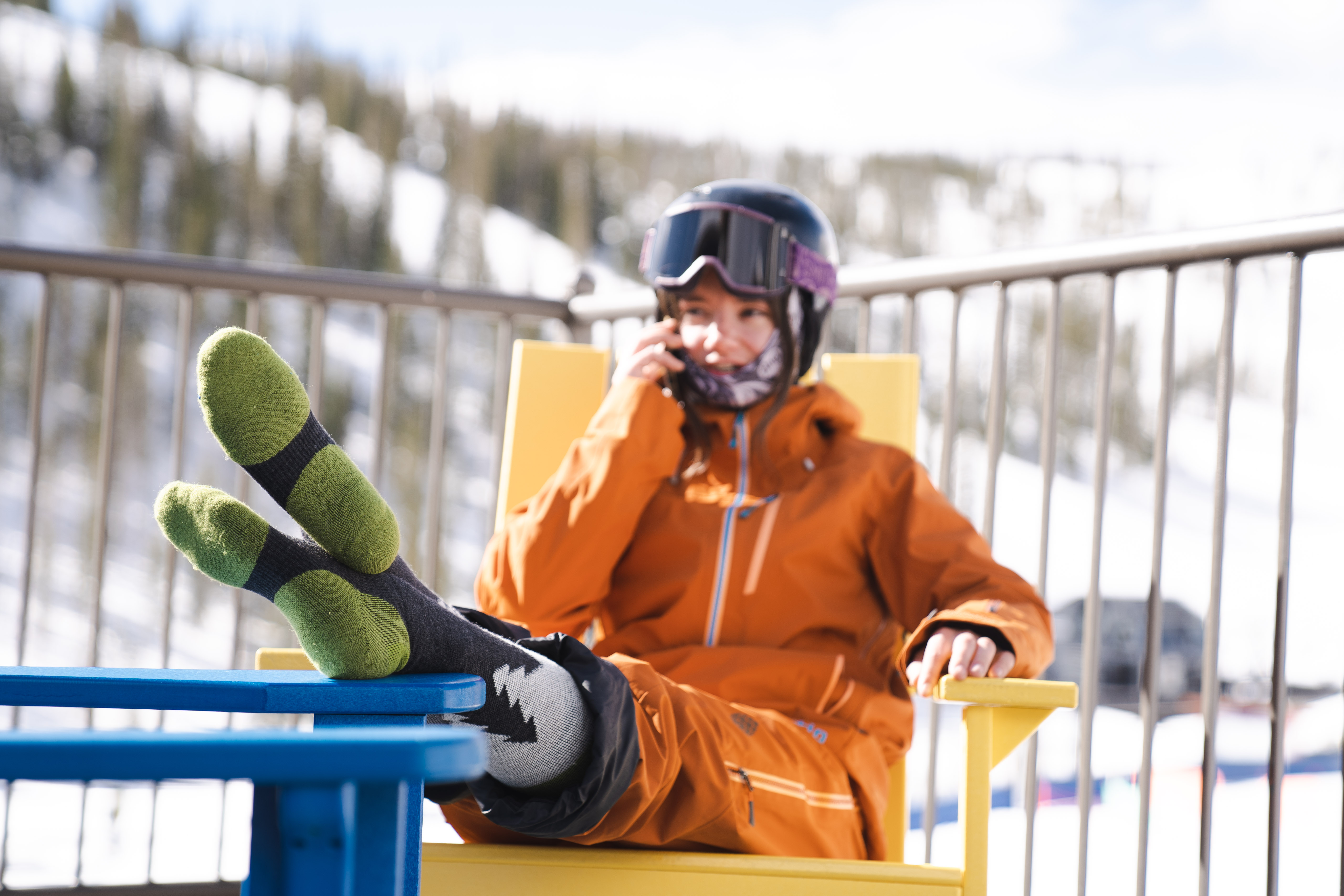
Price & Value
Ski socks can be expensive, we know — 20, 30, sometimes up to 60 bucks for one pair. But if you buy based on the tips and picks we’ve laid out here, know that you will get a great sock when it comes to keeping your feet comfortable, warm, and secure in your boots. You’ll also get one tailored to what you need.
Budget
Our most budget-friendly and inexpensive pick for ski and snowboard socks was the Wigwam Sirocco ($17). Generally, a bottom-barrel price point for your foot’s well-being is anywhere from $15 to $25.
Mid-Tier
Our second price tier features socks that are more built out. You’ll see a greater presence of material by way of overall thickness or targeted cushions or sweeping cushions, as well as more complex construction. Overall, the thicker and more strategically woven a sock is, the longer it will last.
However, this price category can also include lighter-weight socks that are made with high-quality, softer textiles, which don’t necessarily last the longest. Generally, the more synthetic fibers that are present in a sock, the more durable, elastic, and rebounding the apparel is.
This zone includes the Smartwool Targeted Cushion Over The Calf Sock ($28), Le Bent Core Light Snow Sock ($36), Smartwool Ski Full Cushion ($31), Icebreaker Merino Ski Light Over the Calf Socks ($29), and Darn Tough Midweight ($32). Also reasonably priced for the quality are the FITS Light Ski Sierra ($28). All for 30 bucks or under, these ski and snowboard socks are reasonably priced without skimping on any of the details. Including expert design elements and great warranty policies, you can’t go wrong with our middle-tier collection.
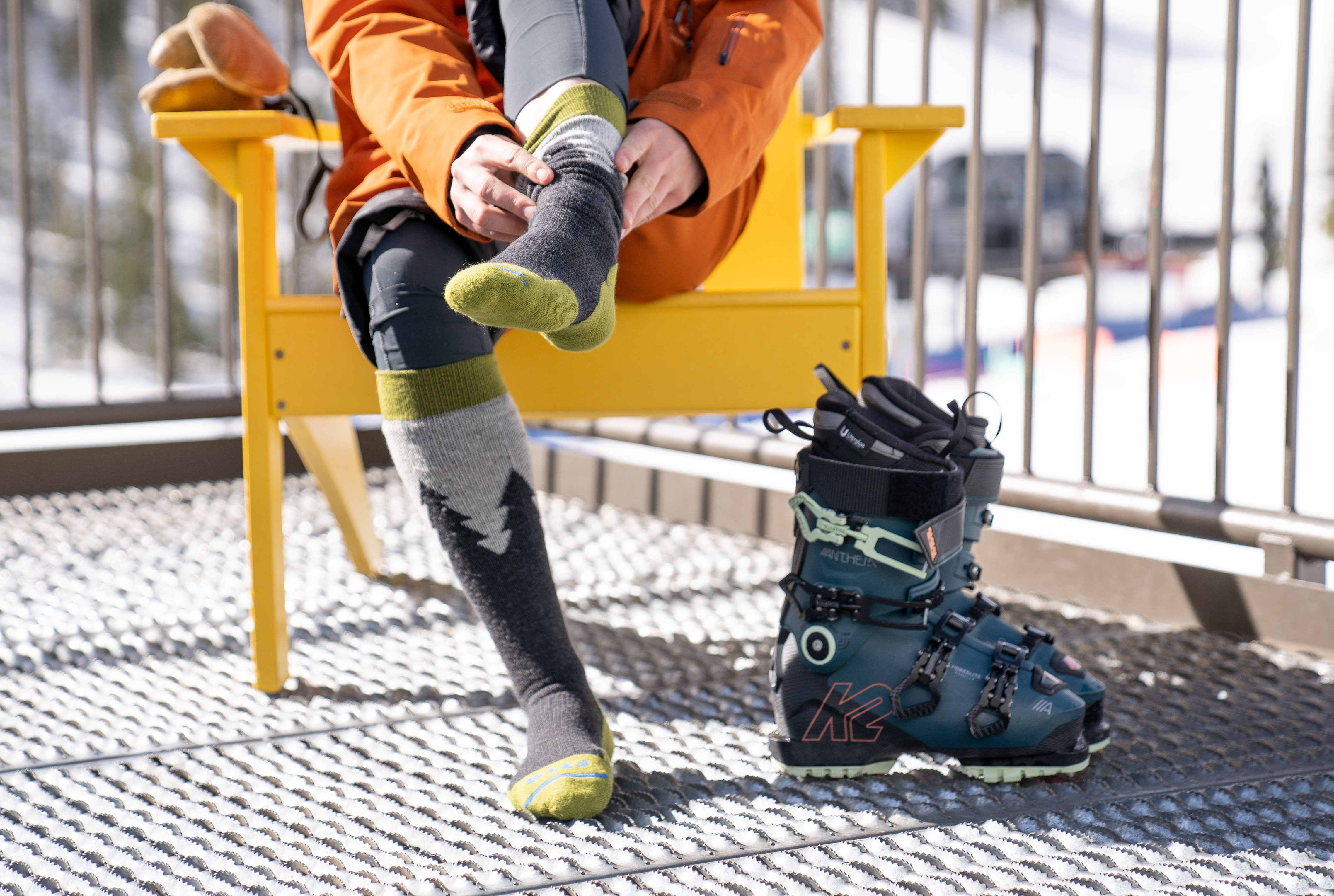
Premium
In our upper-price stadium for ski socks are options that range from 45 bucks up to almost $60. While these socks are pricier, rest assured they are well-made and worth the investment, especially if you will be riding on them all winter long. This level includes the Smartwool Compression, CEP Ski Touring Compression Socks ($55), and Dissent GFX Compression Hybrid ($58). Premium sport hosiery like these options are highly specialized and mostly compression-focused with a tight fit or medical-grade compression for active recovery during and right after a ski or ride day.
Overall, we recommend investing in at least two pairs of high-quality ski and snowboard socks in this aforementioned price range, so that you can wear clean pairs back-to-back on weekends and powder days and not need to do laundry. Your feet, and your boots, will thank you.
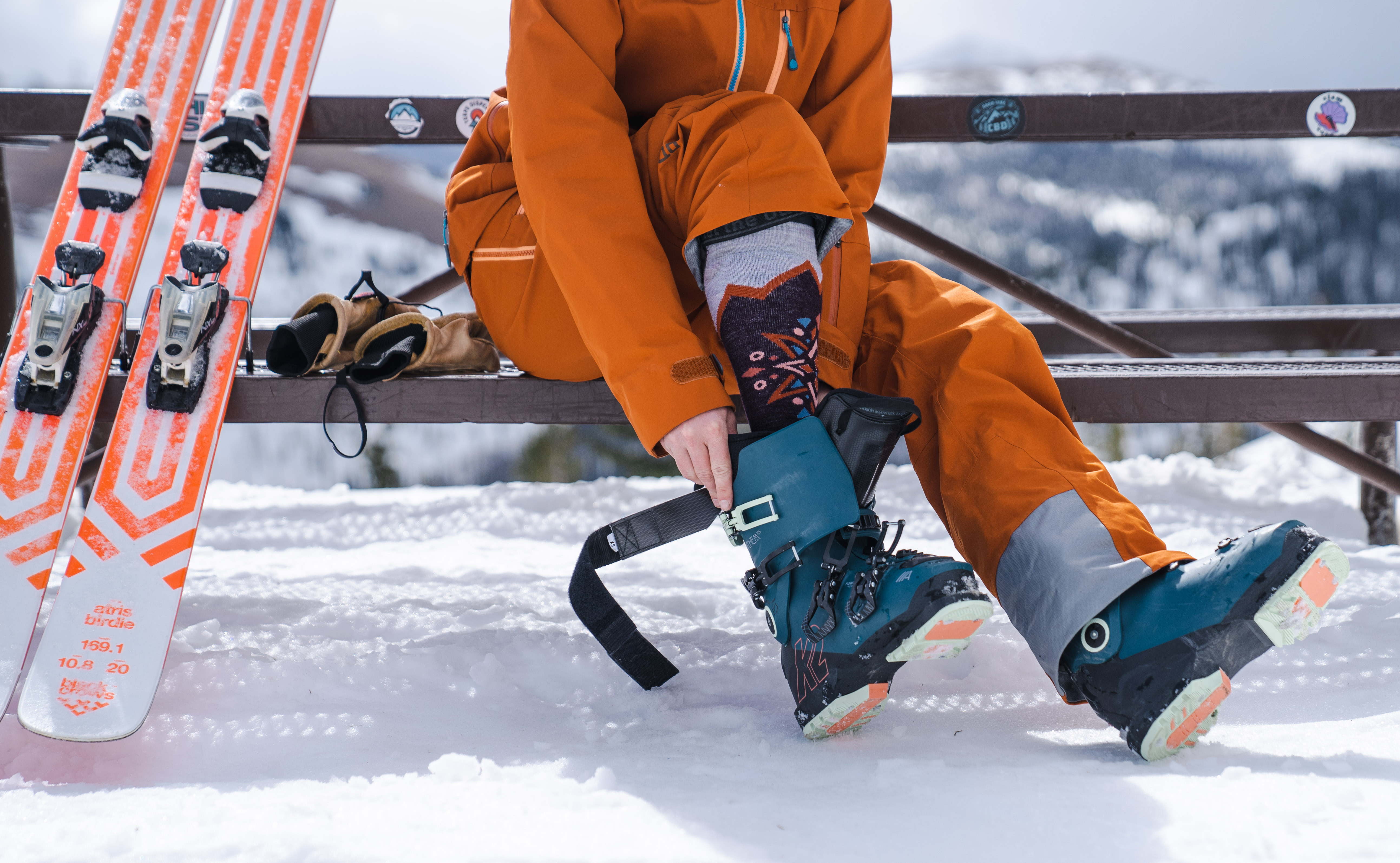
Frequently Asked Questions
There are hundreds of ski socks on the market, curated into dozens of types and styles. We’ve found the best ones for beginners have a balance of support and cushion, a warm yet breathable blend, and come at a lower price.
Some of our expert skiers’ favorites include the Smartwool Ski Full Cushion Over The Calf Socks and Le Bent Core Light Snow Sock — socks with lighter or ultralight cushioning, merino wool fibers, and tailored zones that help balance breathability and warmth.
The warmest ski socks will depend largely on the blend of fabrics and thickness of the sock. Some of the warmest ski socks we tested and best for temps below zero were the Darn Tough Midweight and the Smartwool Full Cushion.
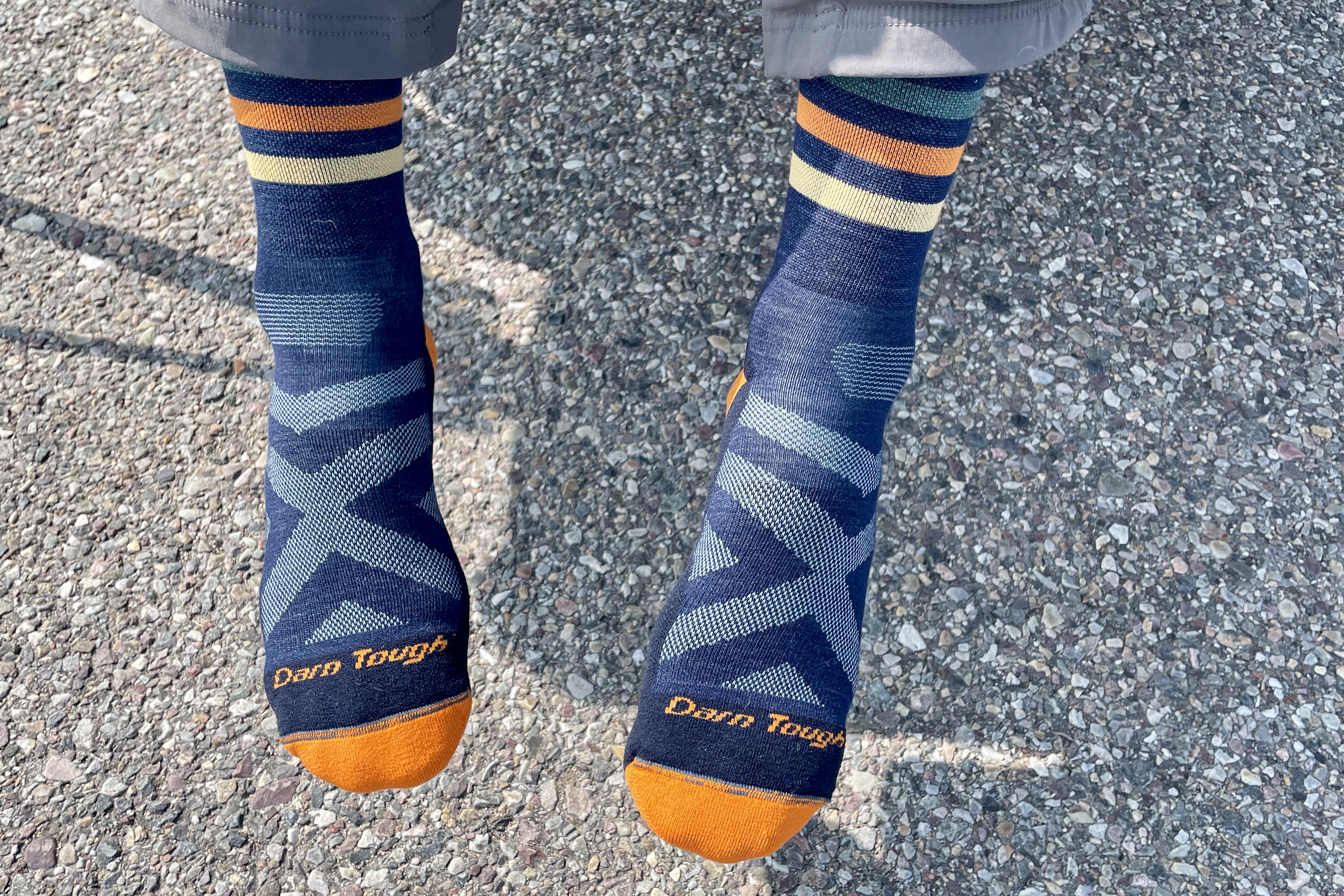
Sock thickness is usually very dependent on what type of skier you are, as well as personal preference. And depending on how your ski or snowboard boot fits, as well as the shape of your feet, you may want a thinner or thicker sock for comfort.
We’ve found most of our expert skiers on staff prefer a lighter-weight sock, while snowboarders on staff are split between light and midweight varieties.
merino wool is a natural fiber with a lot of great properties: breathability, odor-wicking, warmth, and moisture-wicking, to name a few. And each of those factors really come into play when your foot is stuffed inside an insulated, rigid boot all day. But, merino alone is not the most durable over time, which is why it’s often blended with other synthetic fibers.
So, if you prefer a merino blend over pure synthetic options, we’d recommend looking for a sock that has at least 50-60% merino wool — like the Smartwool Full Cushion Sock.
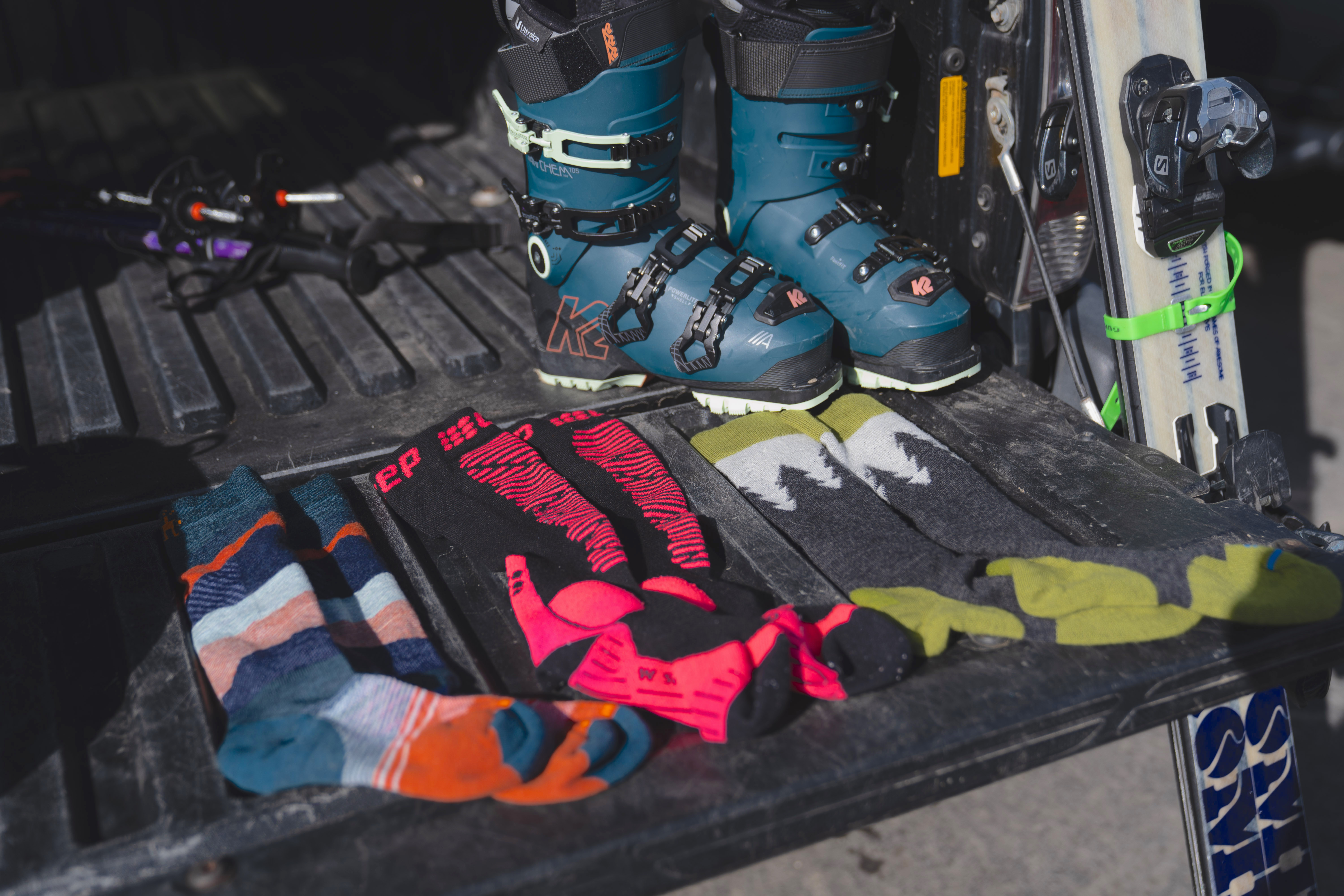
Typically, no. If you have invested into a pair of ski or snowboard socks that support your feet, while also keeping them toasty warm, there is no need to double up. Two pairs of socks worn simultaneously can lead to extra friction and bunching in your boot, causing blisters and uncomfortable crowding.
If your feet feel cold while skiing, make sure you are wearing a sock with enough elasticity and padding to stay put and keep your toes warm, as well a fabric blend that includes a healthy portion of merino wool. The thicker the sock, the more warmth, so try a midweight or even a heavyweight sock.
Also, how old are you ski boots, liners, or footbeds? The other component to keeping your feet warm is a well-constructed and lively boot liner, footbed, and shell, some of which are constructed with various technology to help keep your feet warm.
If you’ve exhausted the basic investment of new socks followed by boots, you can add electronic heat byway of battery-operated insoles or liners, too. But start with a solid sock choice before upping the bill with all those extra tools.
Cold and uncomfortable feet while on the mountain is never fun.
To ensure the longevity of your ski socks, it is important to take care of them through a frequent wash with a gentle detergent and cool water. (Hot water shrinks.) Avoid using any fabric softeners or bleach, as this can damage the fibers of the sock, thus leading to fraying and loss of insulation abilities. To ensure the wool stays in its best shape, hang or lay your socks flat to dry after you’ve washed them.
After a day of skiing or snowboarding, we recommend taking your socks off as soon as you get back to the car or lodge. While most socks have superb moisture-wicking abilities, to keep your socks in the best shape possible we suggest not overusing them. This will ensure your ski socks last you several seasons, rather than just one.
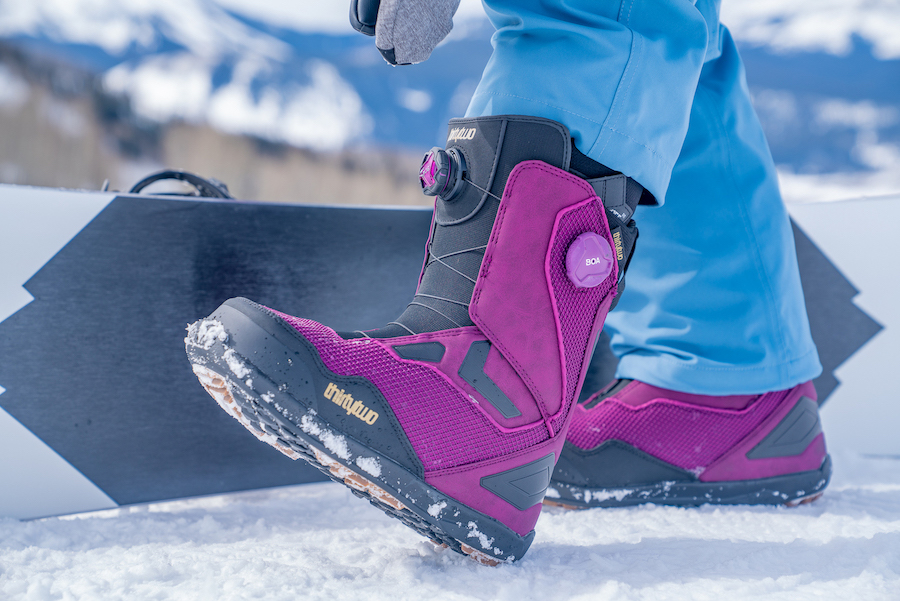
The Best Snowboard Boots of 2025-2026
We tested all-mountain and freestyle snowboard boots for the resort and backcountry to find the best options from Burton, Vans, K2, and more.
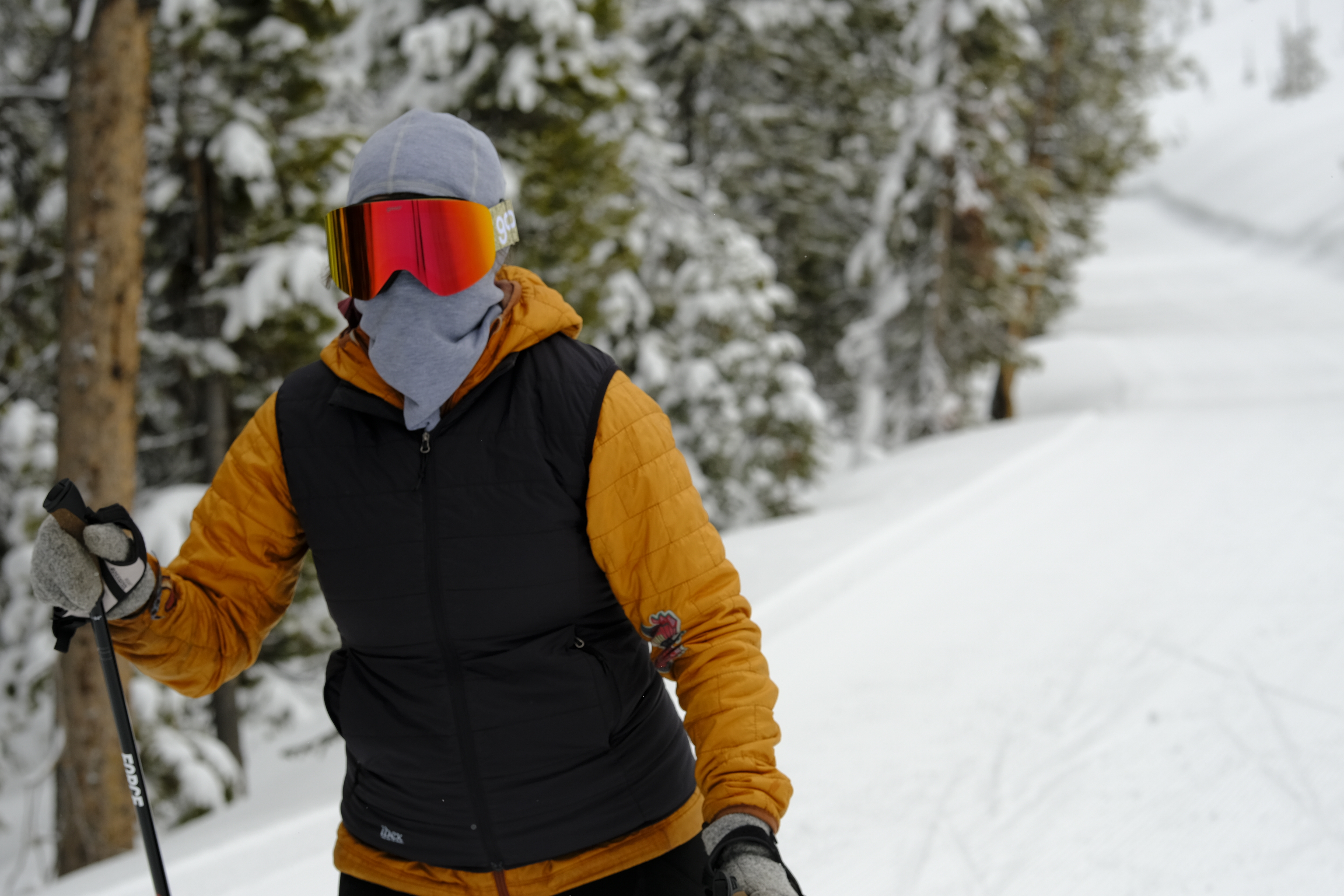
The Best Face Coverings for Skiing & Snowboarding of 2025-2026
We tested the best face coverings for skiing and snowboarding from Turtle Fur, Buff, REI, Smartwool, and more to help you find the best option for your needs and budget.
